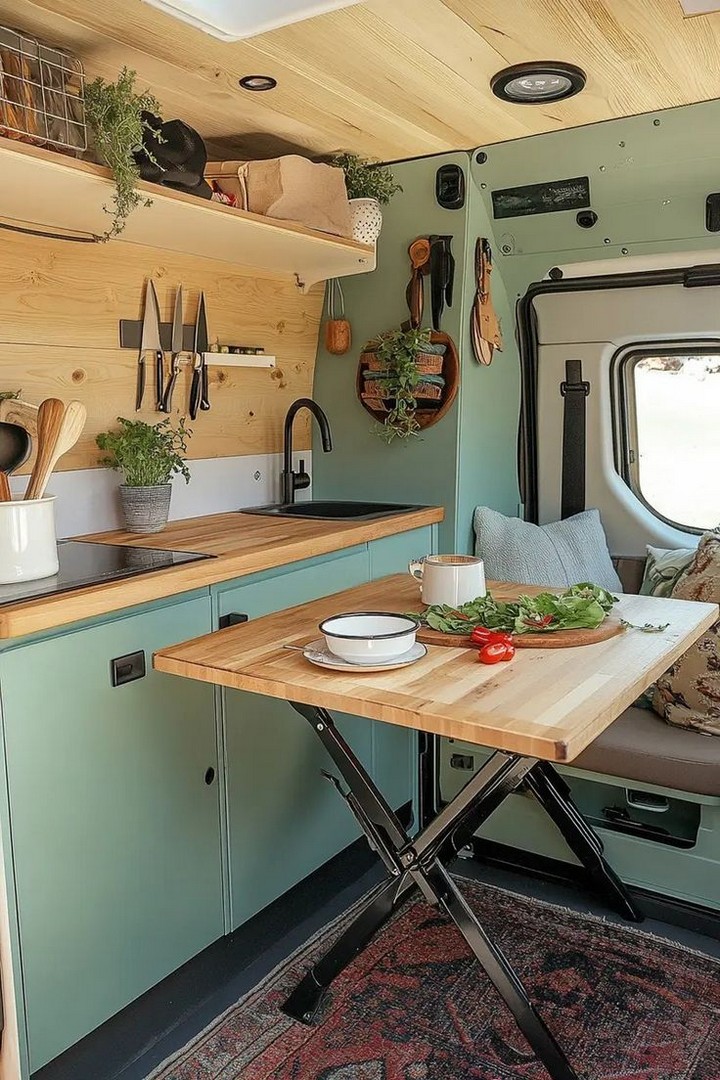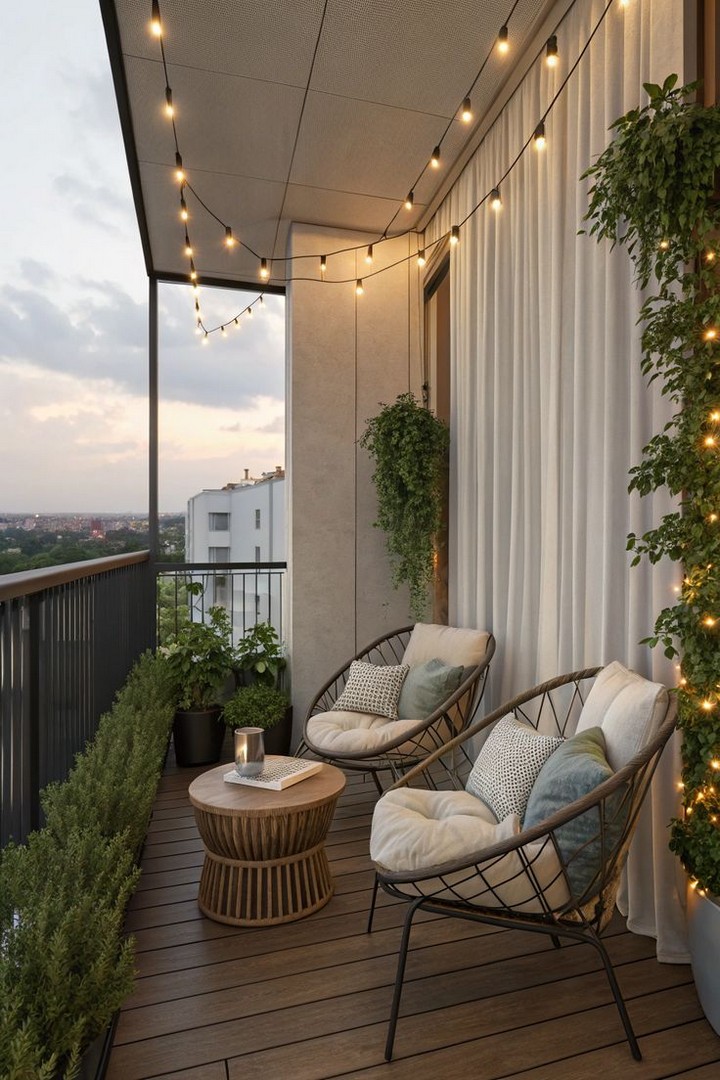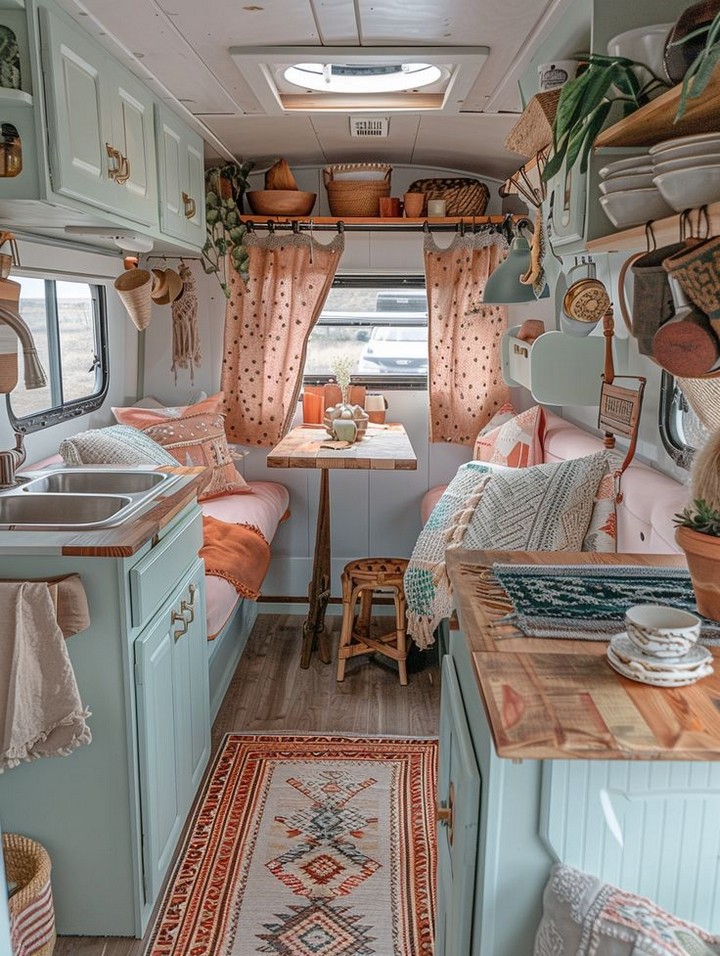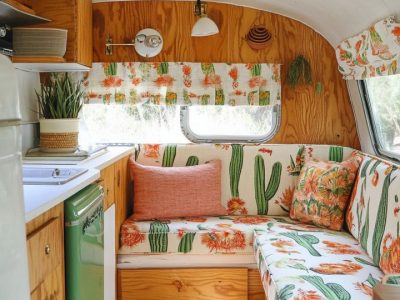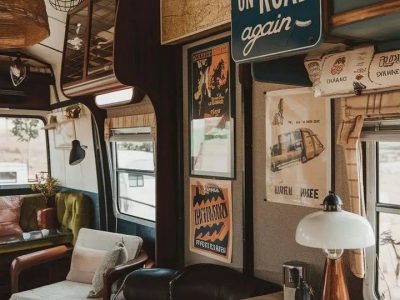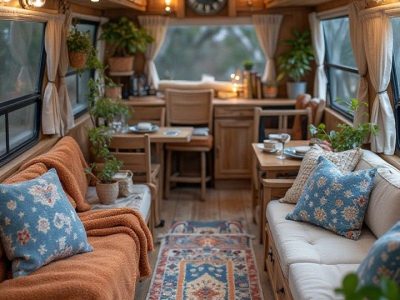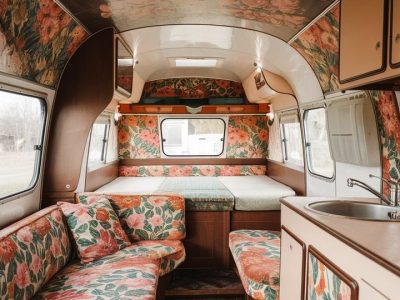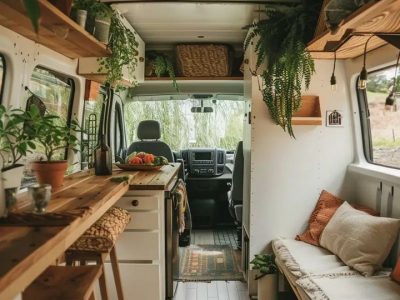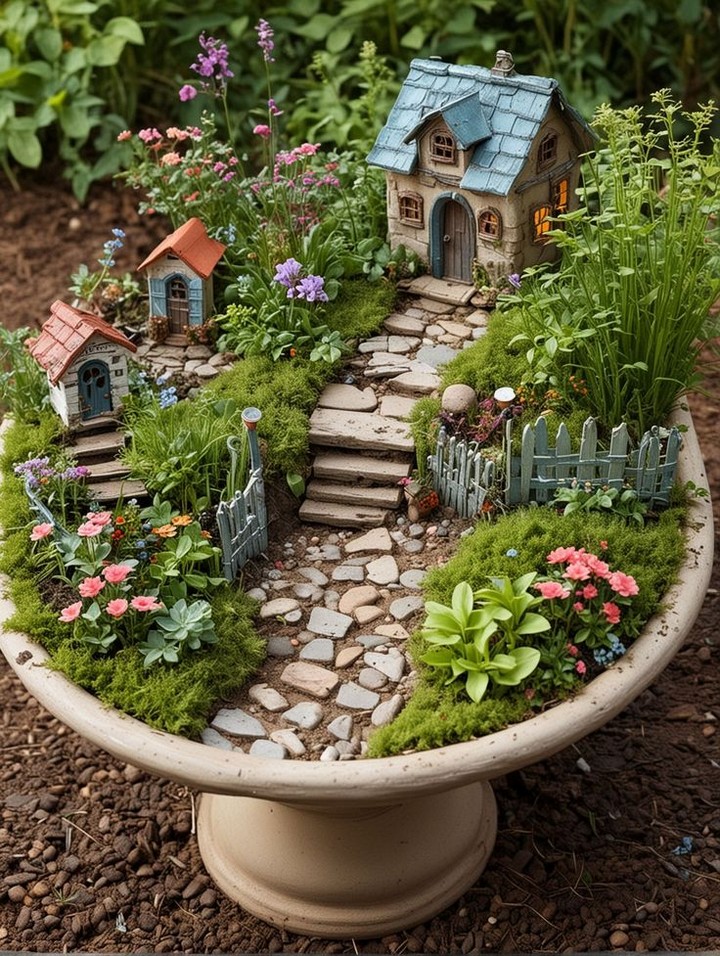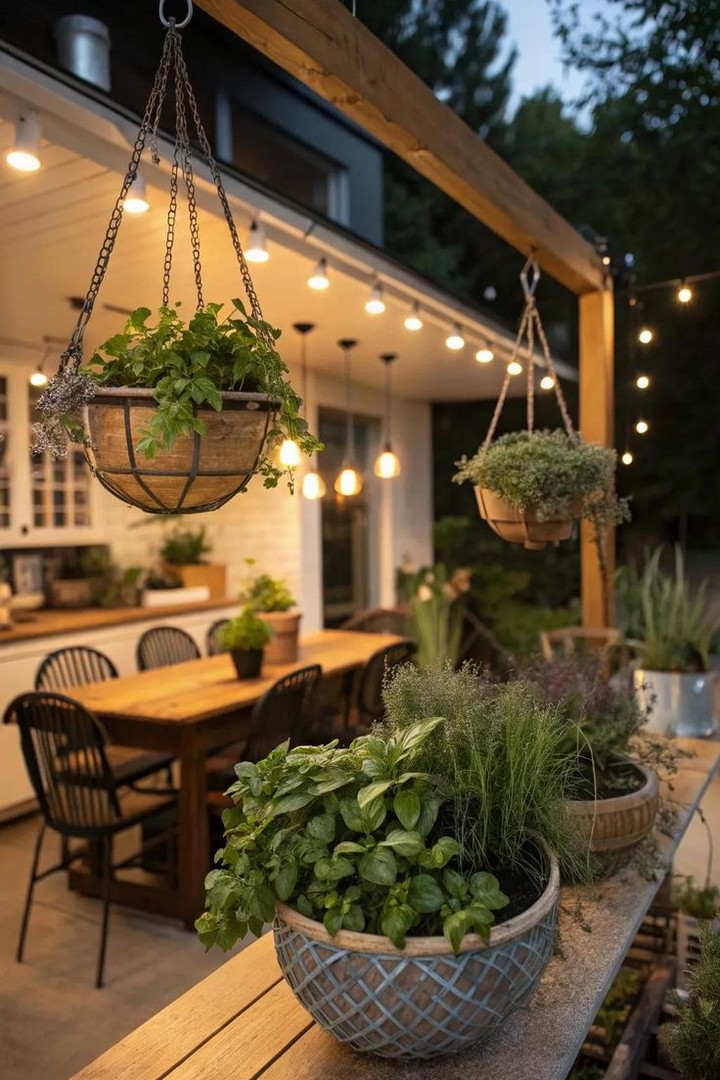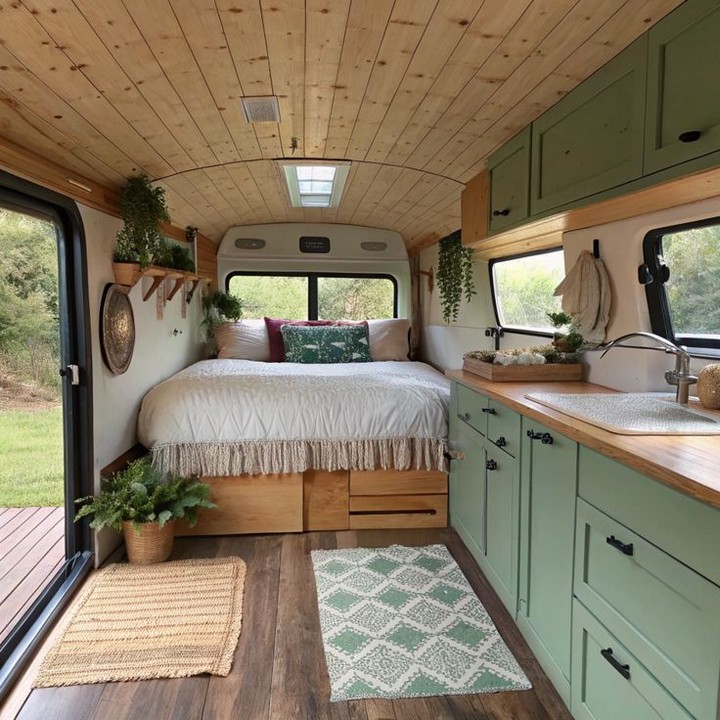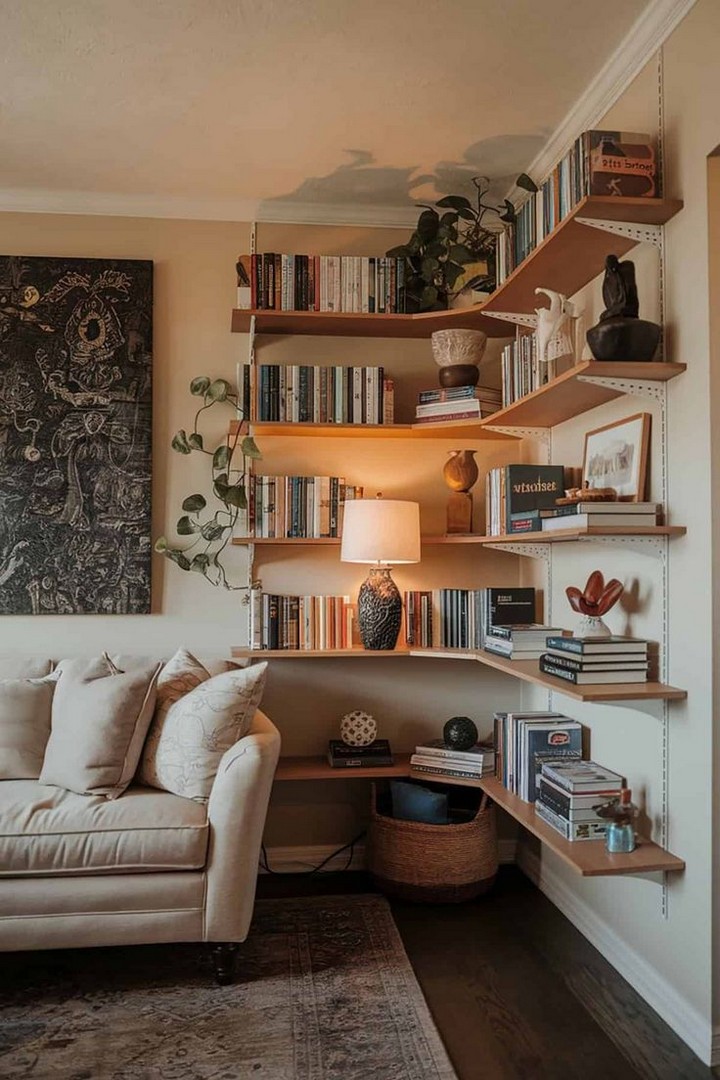The heart of any home is the kitchen even when that home has wheels. For Sprinter van conversions, creating a functional yet aesthetically pleasing kitchen space presents unique challenges and opportunities. Rustic wood elements have emerged as a particularly popular choice among van builders, bringing warmth, character, and natural beauty to compact mobile living spaces. This comprehensive guide explores 44 innovative ways to incorporate rustic wood into your Sprinter van kitchen, from fundamental design considerations to specific implementation ideas.
The modern nomadic lifestyle has turned Sprinter vans into full-time homes and travel companions. One of the most vital areas in any van build is the kitchen. If you’re dreaming of a van kitchen that feels like a rustic cabin on wheels.
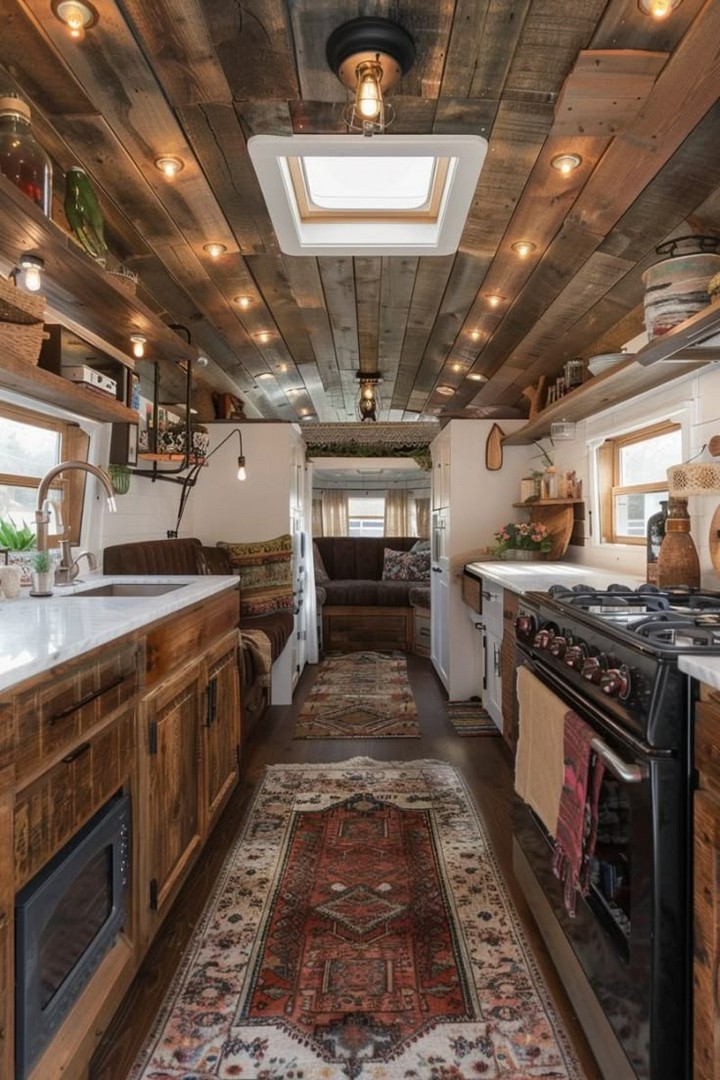
Rustic wood kitchen transforms your Sprinter van into a warm, inviting home on wheels blending natural textures, durable craftsmanship, and functional design for life on the road. Whether you’re a weekend warrior or a full-time nomad, a well-designed kitchen makes cooking, storage, and daily living effortless.
Before diving into specific design options, it’s worth understanding why rustic wood has become such a staple in van build kitchens.
1. Natural Durability
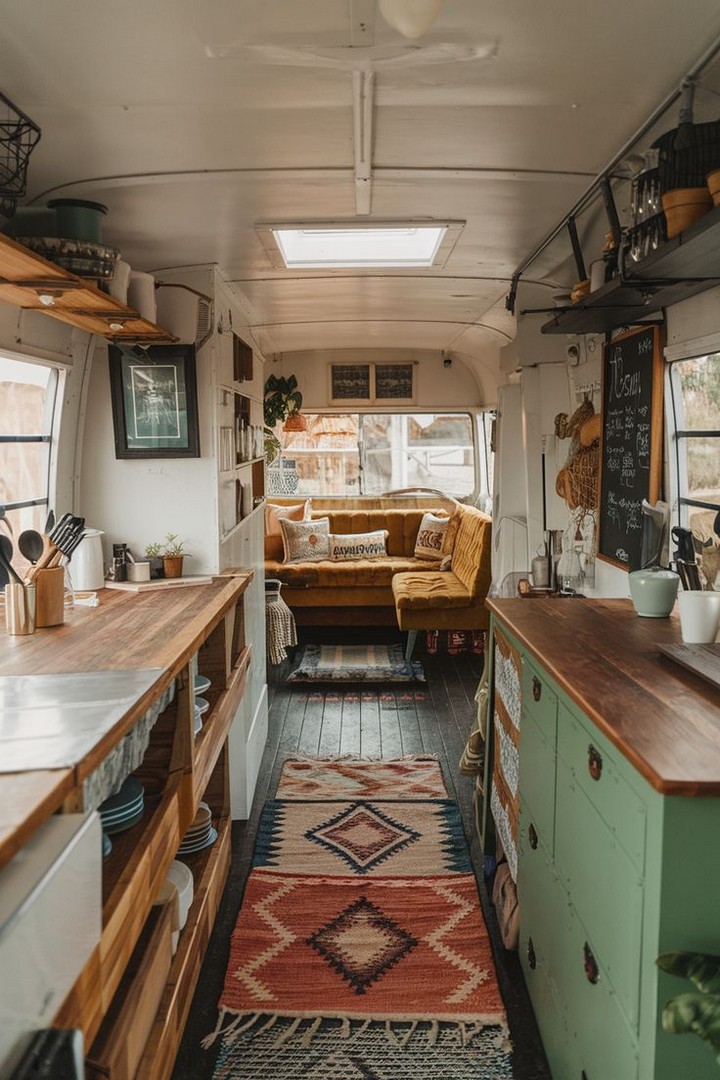
Properly treated wood stands up to the rigors of mobile living, handling vibration and movement better than many synthetic alternatives. Woods with natural hardness like oak, maple, and walnut particularly excel in this environment.
2. Visual Warmth in Limited Space
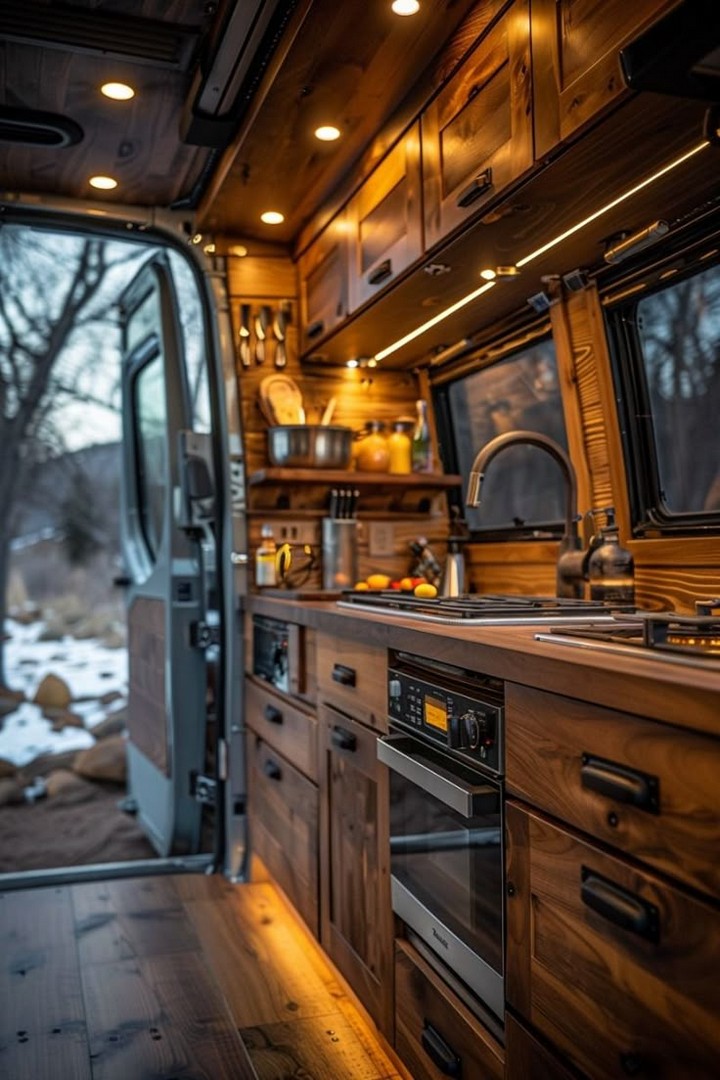
The rich tones and organic grain patterns of wood create a sense of hominess that transforms utilitarian vehicle interiors into inviting living spaces. This psychological benefit shouldn’t be underestimated when designing a space you’ll spend significant time in.
3. Connection to Nature
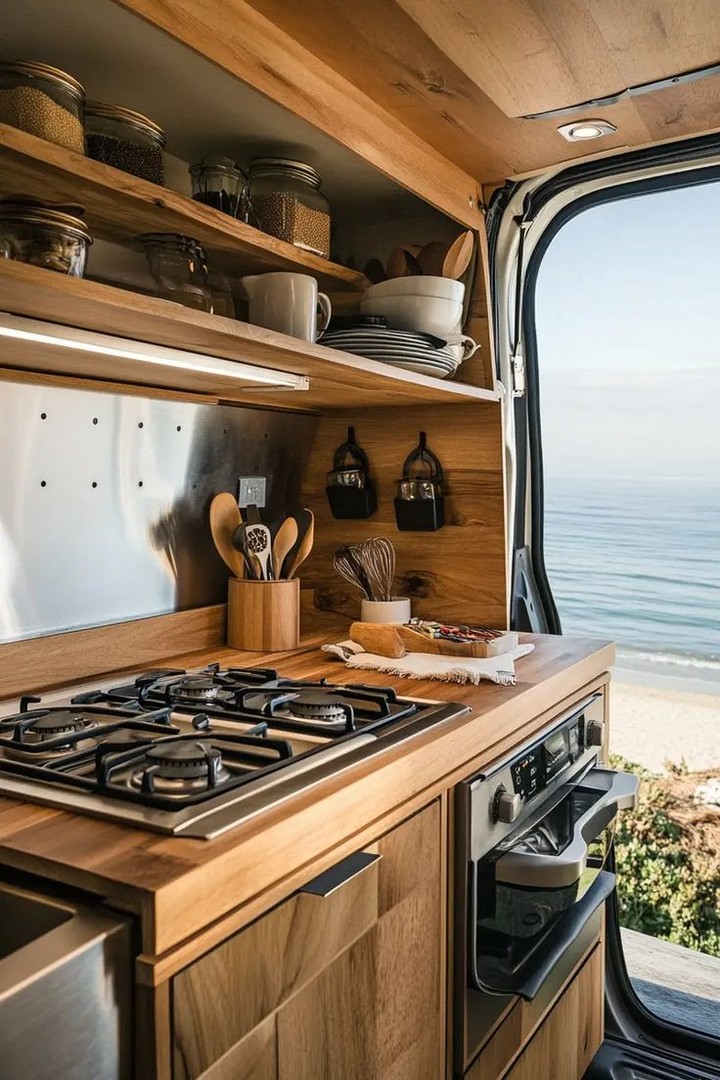
For many van dwellers, proximity to the natural world is a primary motivation. Rustic wood elements maintain that connection even while inside your vehicle, creating a harmonious transition between outdoor adventures and indoor comfort.
4. Adaptability and Repairability
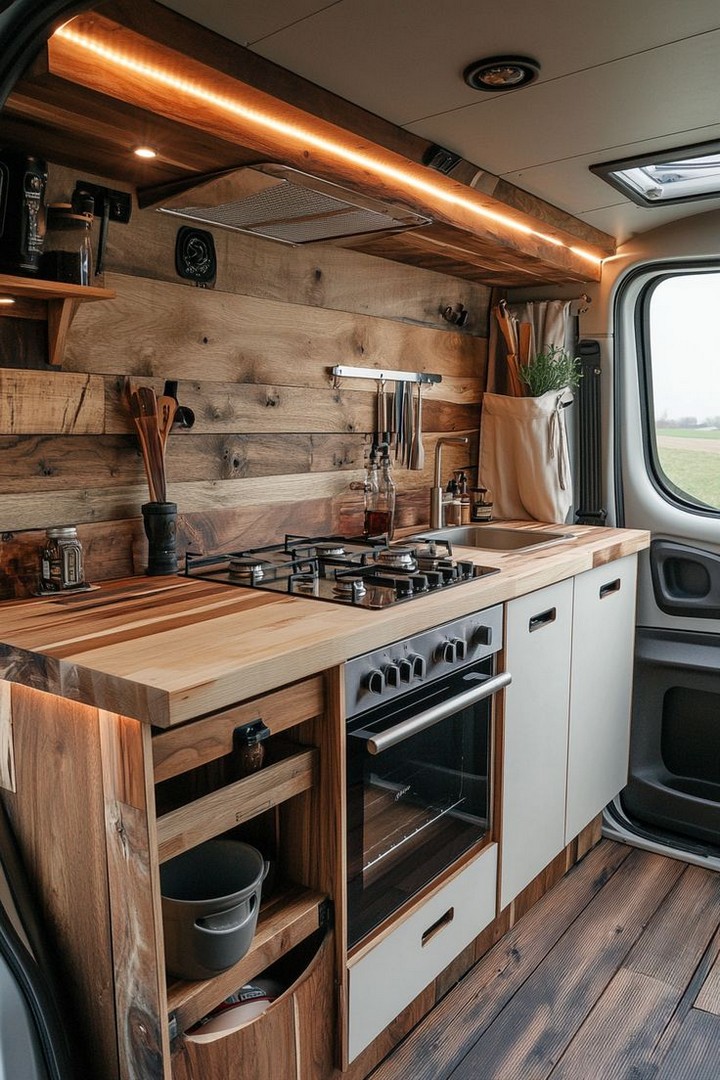
Unlike prefabricated components, wood elements can be easily modified, repaired, or replaced on the road—an important consideration for travelers far from specialized services.
Planning Your Rustic Wood Sprinter Kitchen
Before implementation, thoughtful planning will ensure your wood elements serve both practical and aesthetic purposes.
5. Efficient Workflow Design
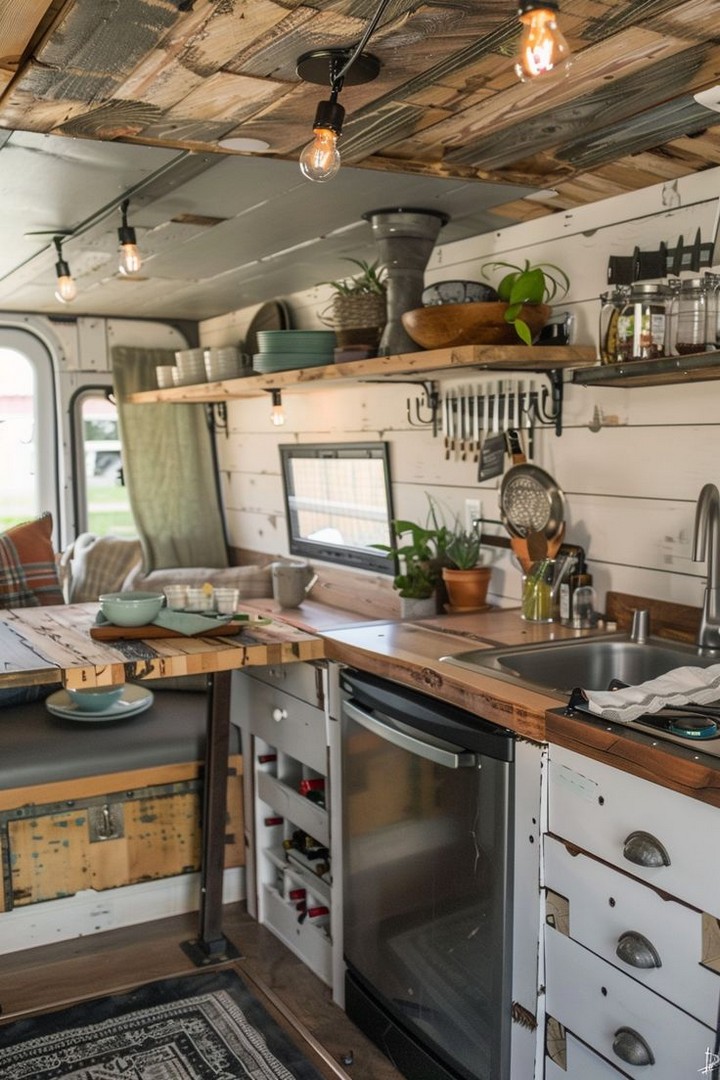
Even in the smallest kitchen, consider the classic work triangle connecting cooking, washing, and food storage areas. In Sprinter conversions, this often translates to a linear arrangement with careful attention to proximity.
6. Height Customization Opportunities
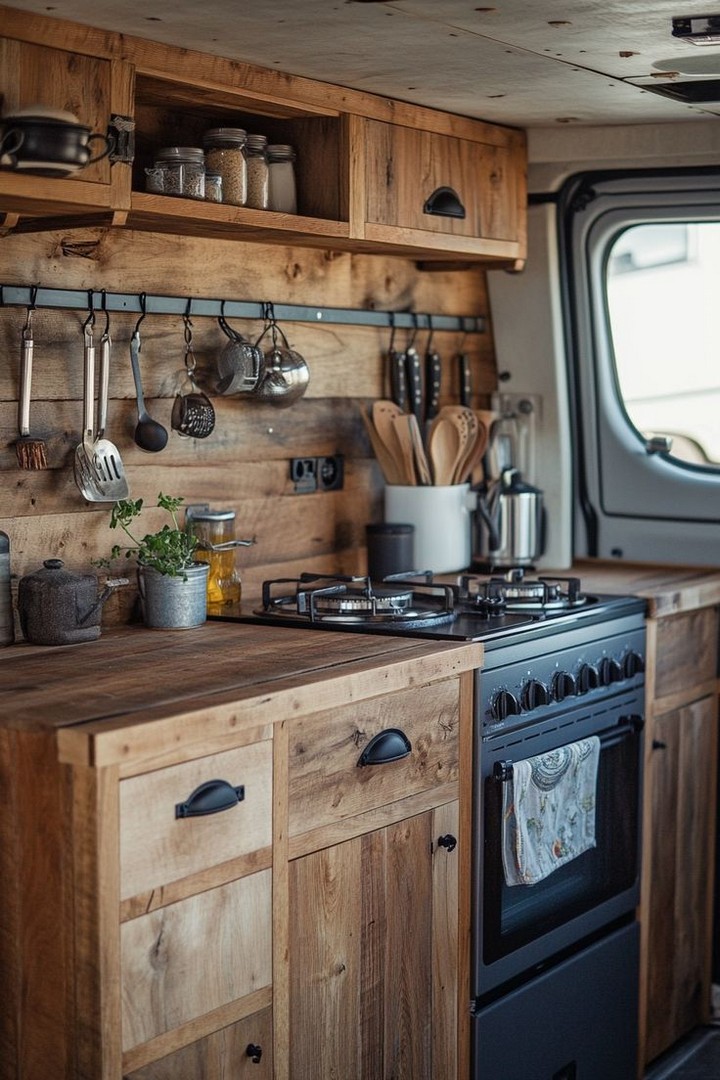
Standard kitchen dimensions rarely apply in van conversions. Wood construction allows for precise height customization based on the primary cook’s height and preferences—a significant advantage over prefabricated options.
7. Weight Distribution Considerations

Wood species vary dramatically in weight. For vehicle performance and fuel efficiency, balance the appeal of dense hardwoods with their weight implications, perhaps reserving heavier species for smaller accent elements.
8. Humidity and Temperature Fluctuations
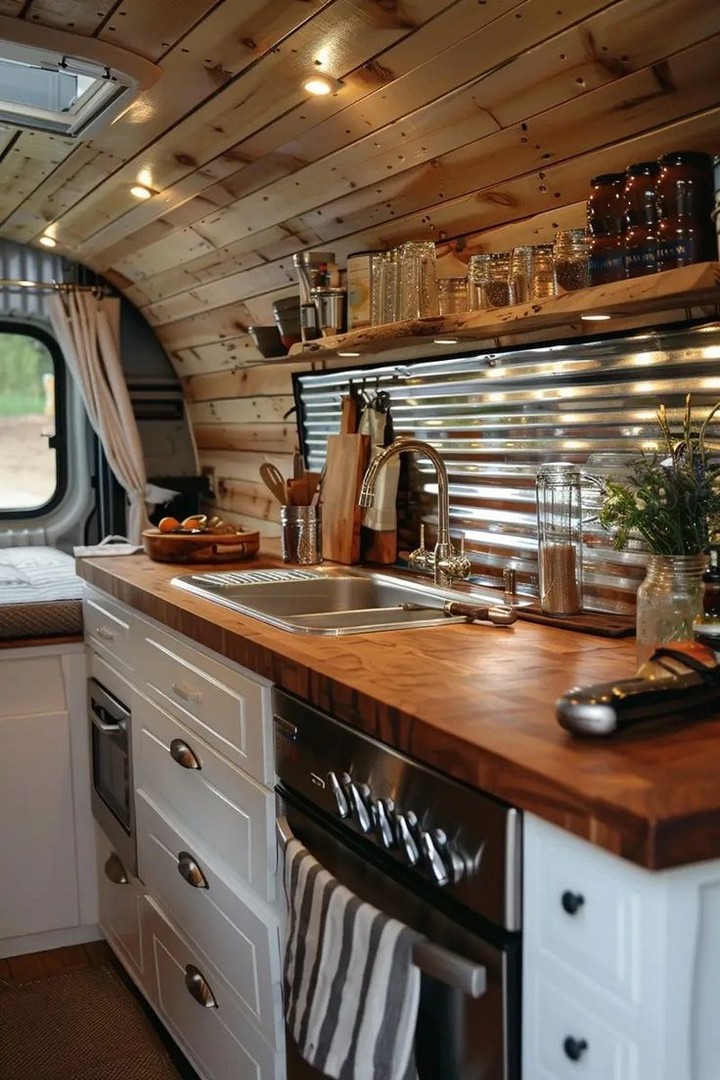
Van environments experience extreme temperature and humidity variations. Select and treat woods that resist warping and expansion/contraction issues, or design with these natural movements in mind.
Countertop Options
The countertop serves as both workspace and visual focal point in compact van kitchens.
9. Live Edge Slab Statement Pieces
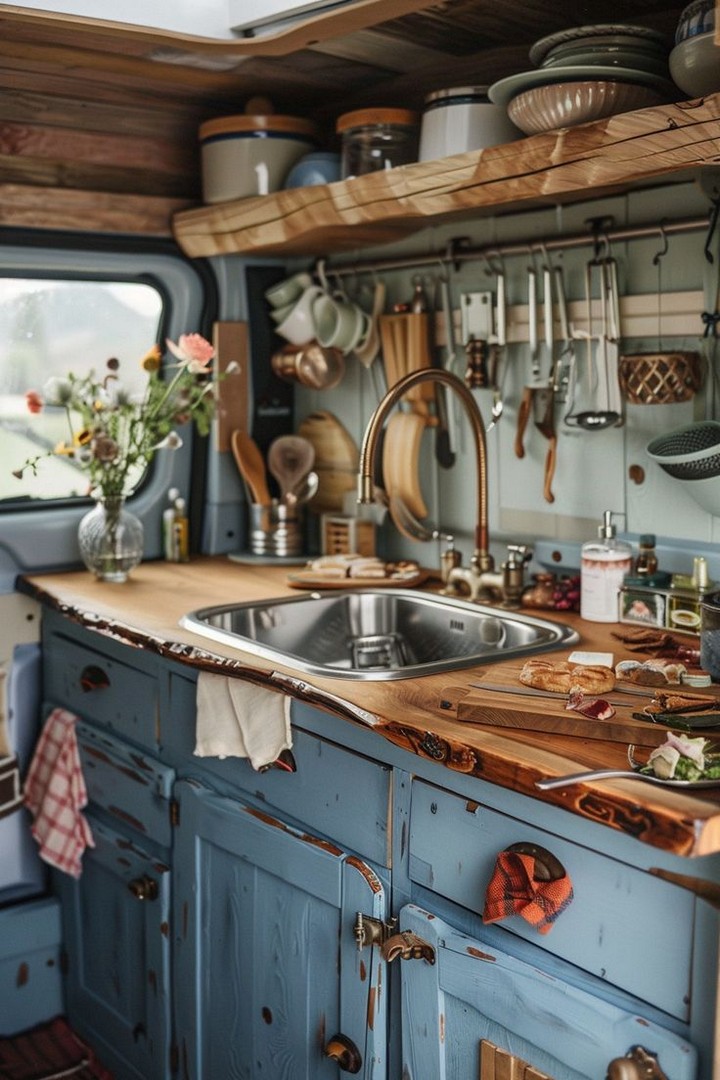
A single piece live edge countertop preserves the natural contour of the tree, creating an organic, one-of-a-kind surface. While potentially heavier than alternatives, nothing matches its visual impact.
10. End Grain Butcher Block Work Surfaces
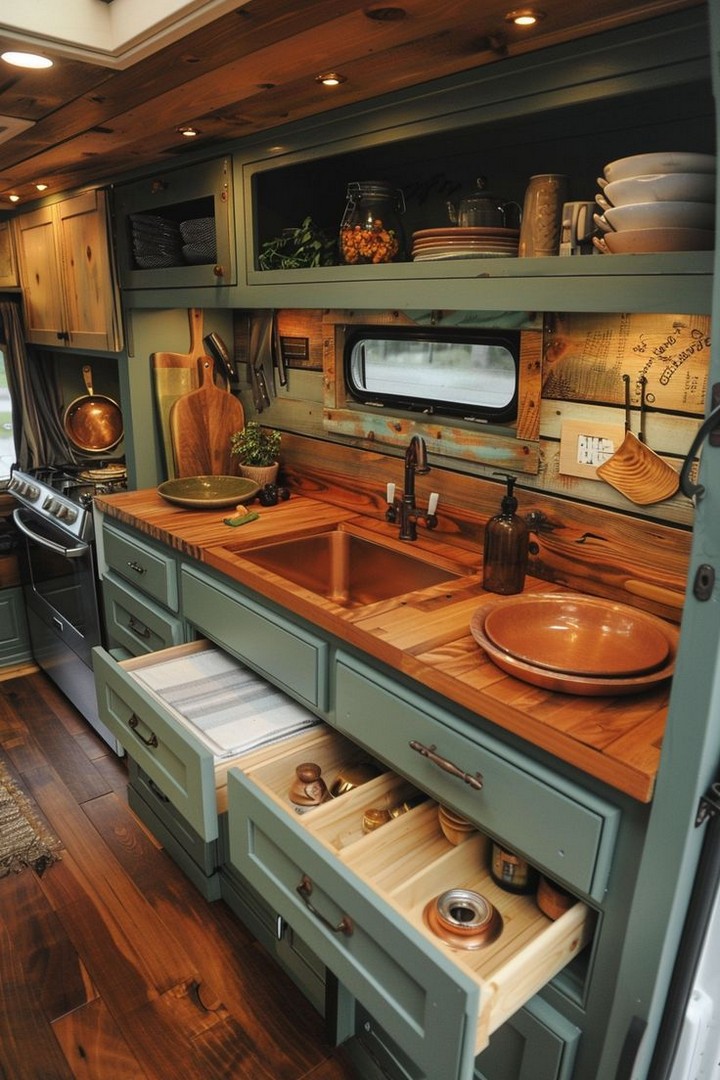
End grain construction (where wood grain faces upward) provides exceptional durability for cutting and food preparation while showcasing spectacular natural patterns.
11. Reclaimed Barn Wood Character Counters
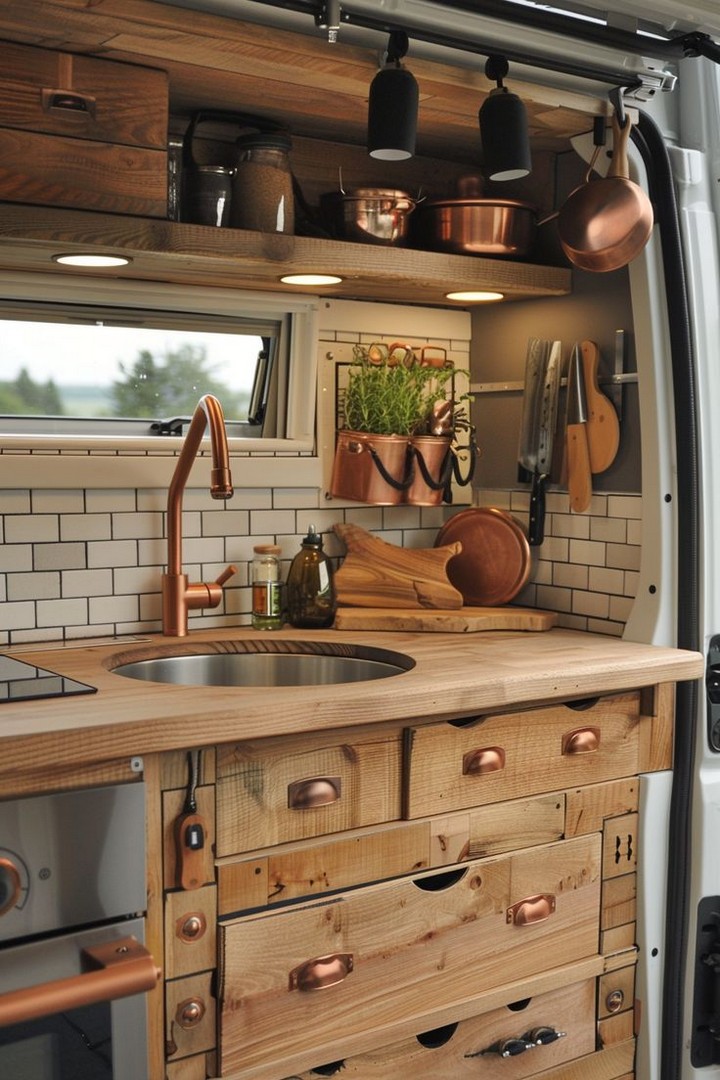
Weathered barn wood, properly cleaned and sealed, brings history and texture to your countertop. The patina of decades can’t be replicated and tells a story all its own.
12. Epoxy River Countertops
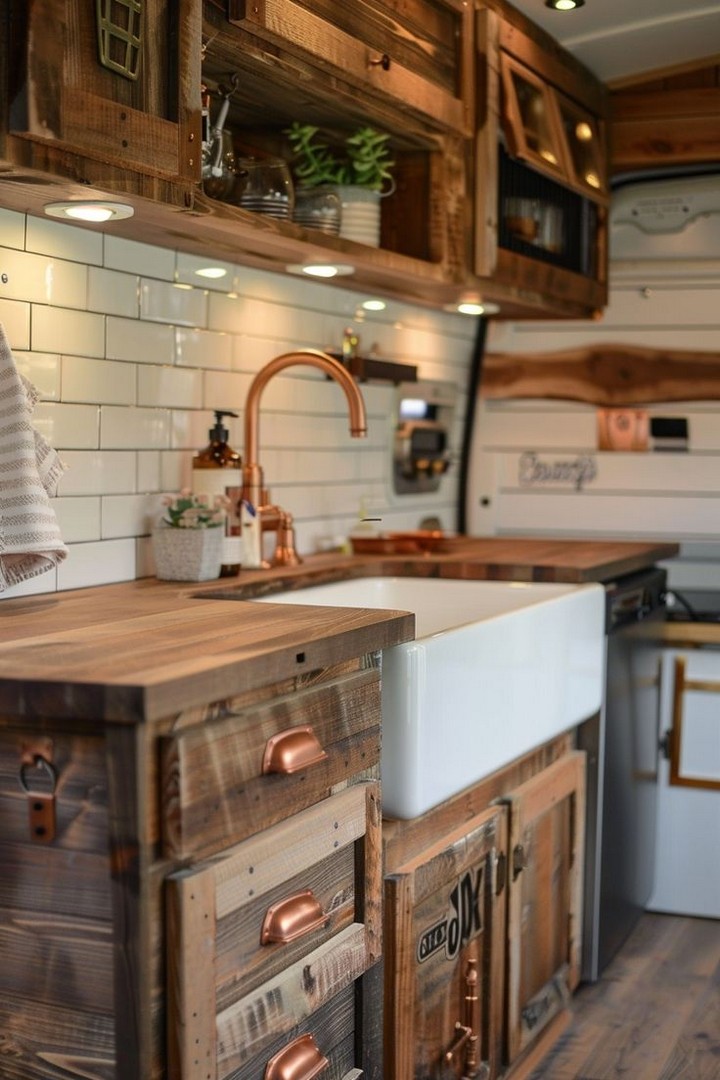
Combine wood with colored epoxy “rivers” to create stunning visual effects while adding water and stain resistance. This technique allows for creative color coordination with other van elements.
13. Staggered Wood Plank Surfaces
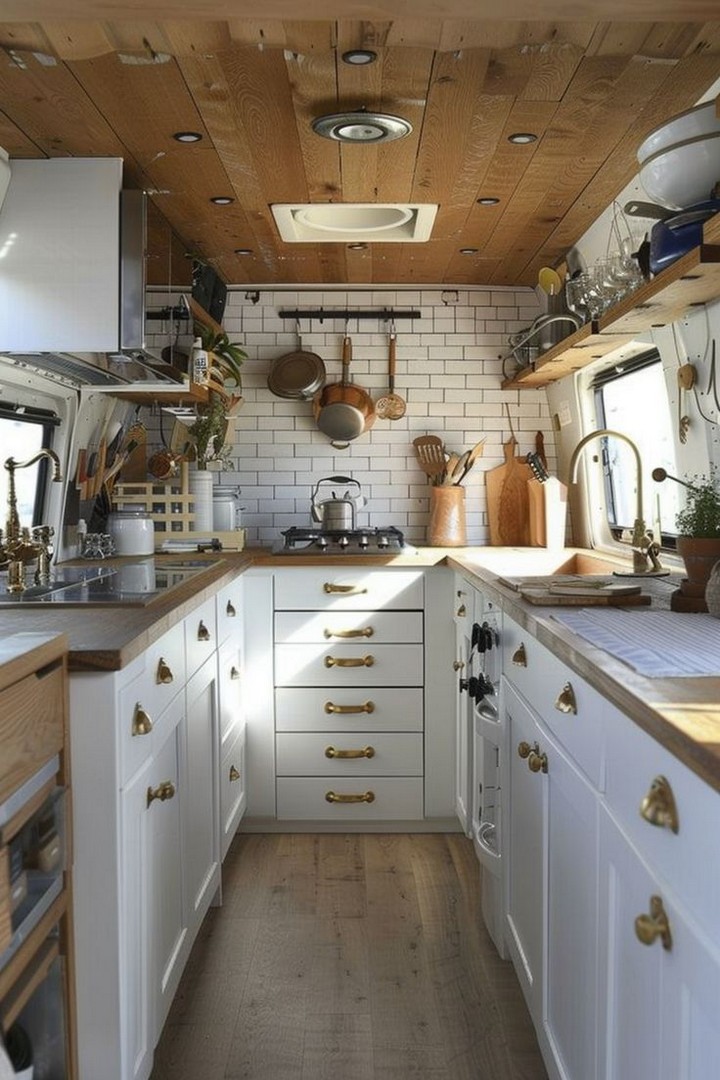
Alternating wood species or stain colors in a plank arrangement creates visual rhythm in the limited counter space. This approach also allows for integrating wood scraps, reducing waste.
Cabinetry and Storage Solutions
Efficient storage defines successful van kitchens, and rustic wood offers numerous approaches.
14. Shaker-Style Door Simplicity
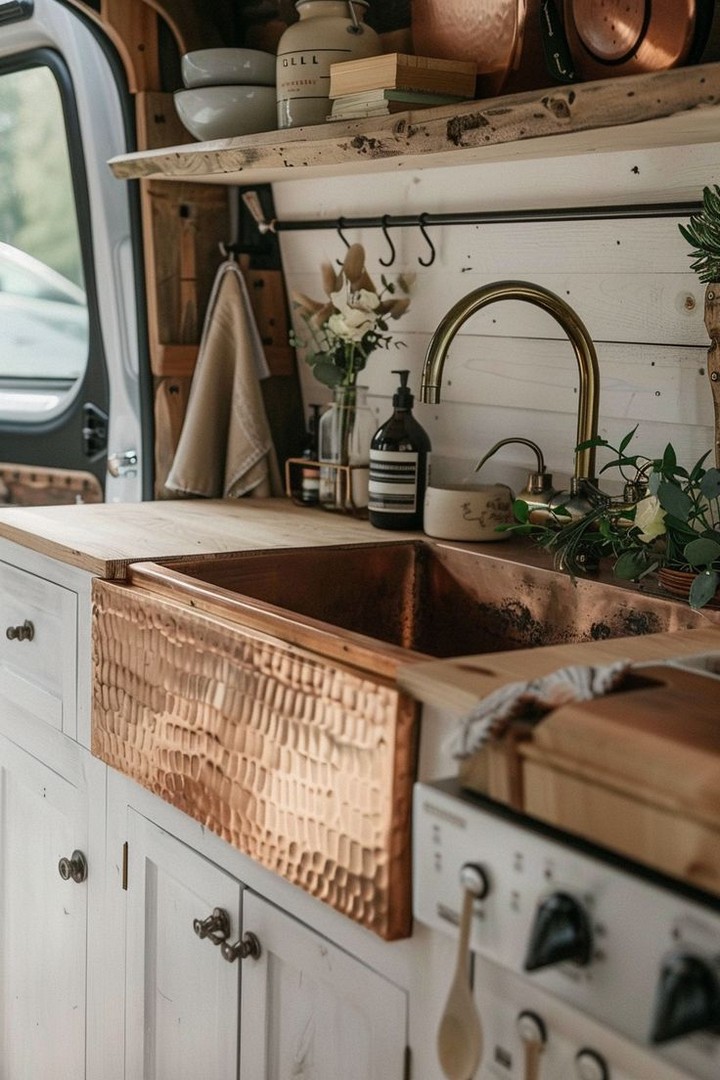
The clean lines of Shaker cabinet doors provide timeless appeal while allowing the wood grain to remain the star. Their simple construction also makes them more feasible for DIY builders.
15. Open Shelf Accessibility
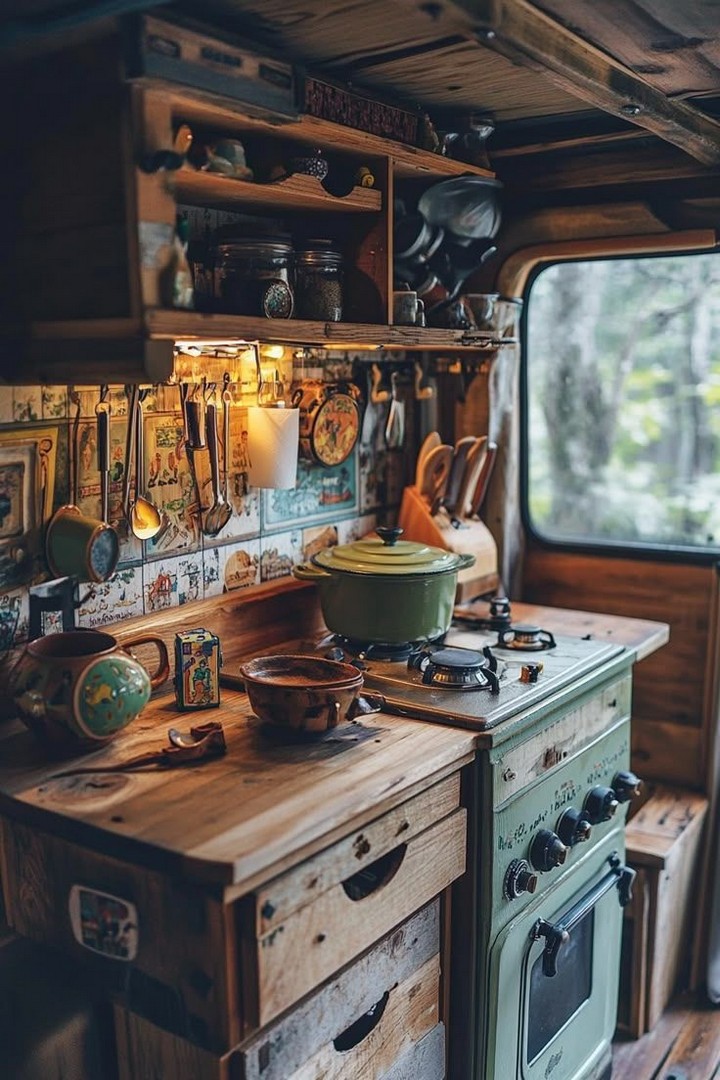
Eliminating upper cabinet doors in favor of open shelving creates a more spacious feeling while keeping items accessible. Wood shelves with metal brackets blend rustic and industrial aesthetics effectively.
16. Sliding Barn Door Cabinet Fronts
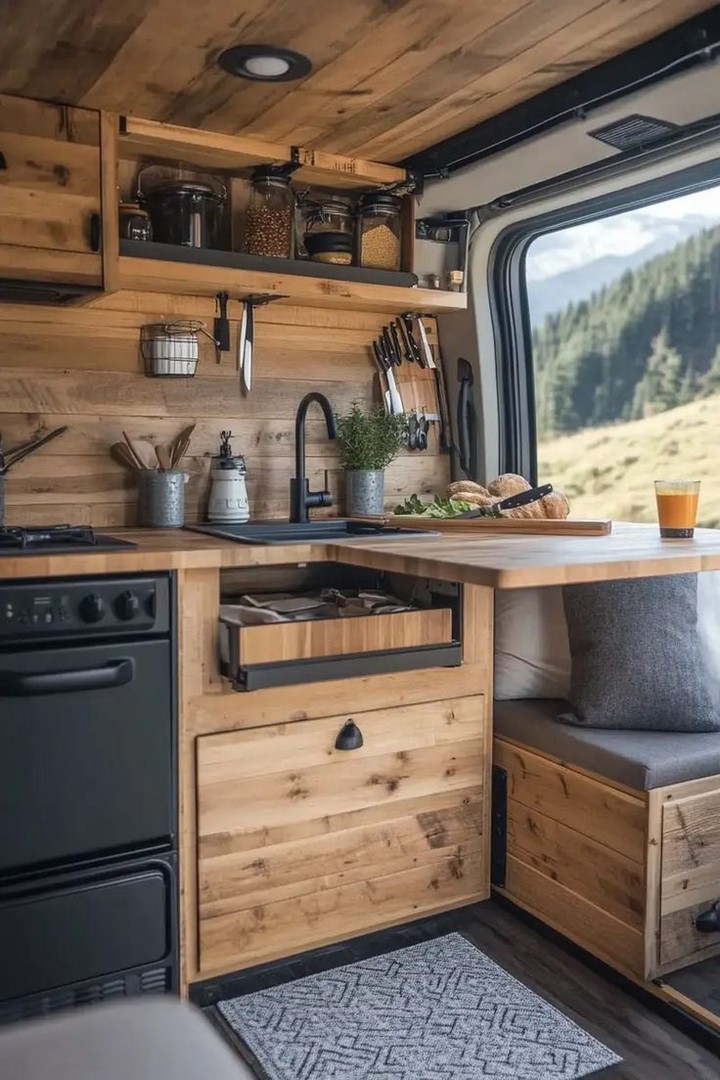
Miniature sliding “barn doors” on cabinets save valuable space by eliminating swing clearance requirements while adding undeniable rustic charm.
17. Woven Wood Panel Inserts
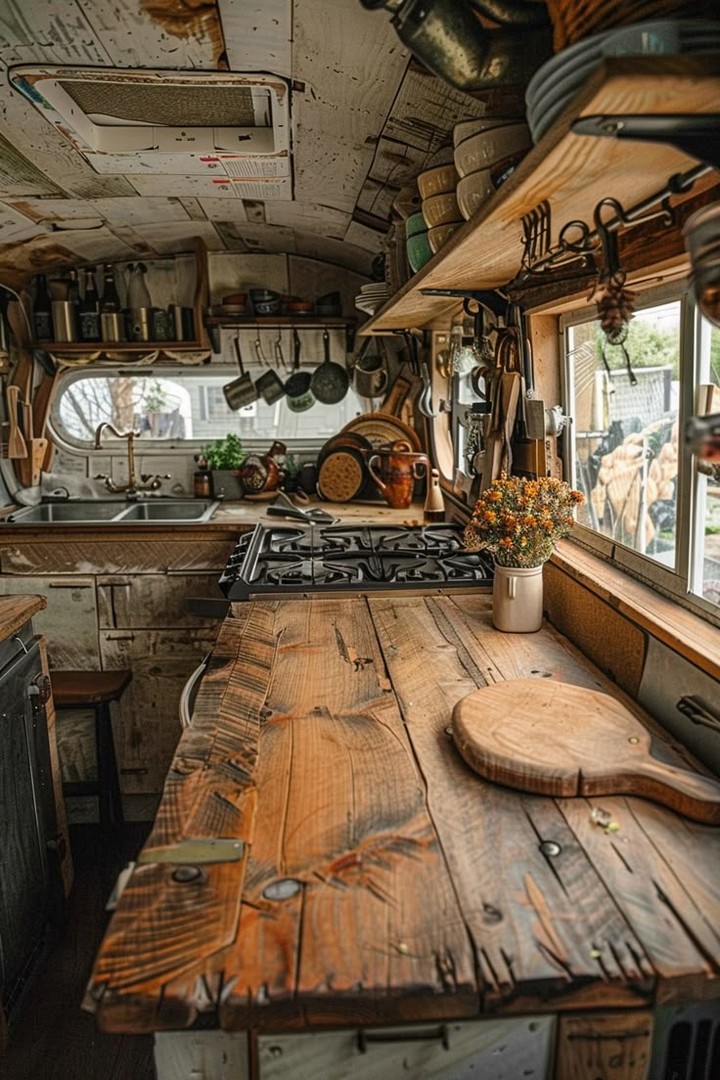
Replace standard cabinet panels with woven wood patterns for ventilation and visual interest. This works particularly well for storing fruits, vegetables, or freshly washed items that benefit from air circulation.
18. Pull-Out Cutting Board Solutions
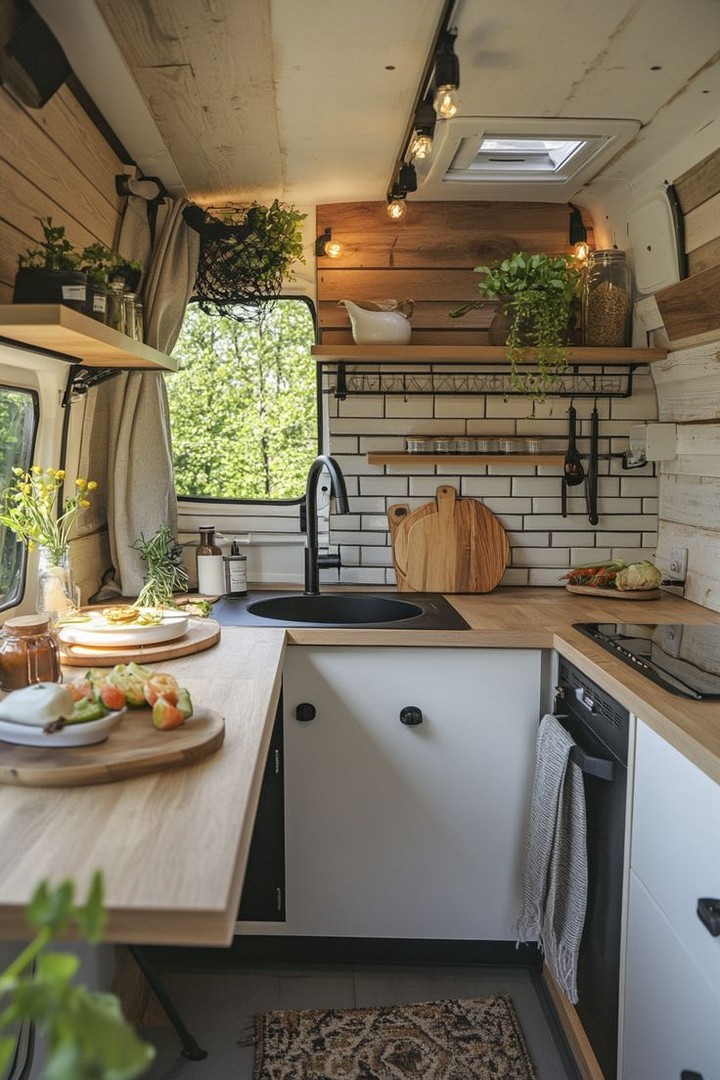
Integrate wooden cutting surfaces that slide out when needed and disappear when not in use. These can double as counter extensions during meal preparation.
19. Custom Wooden Drawer Organizers
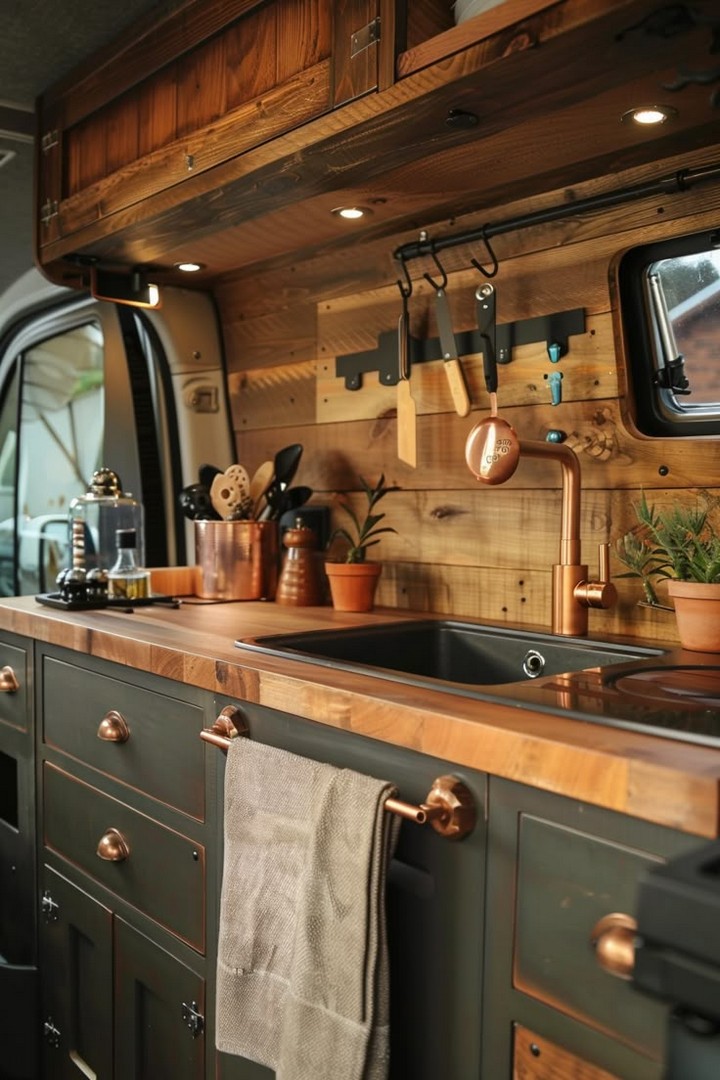
Maximize storage efficiency with dividers and organizers custom-fit to your specific utensils and cooking equipment. These prevent shifting during transit—a common van life frustration.
20. Woven Branch Cabinet Handles
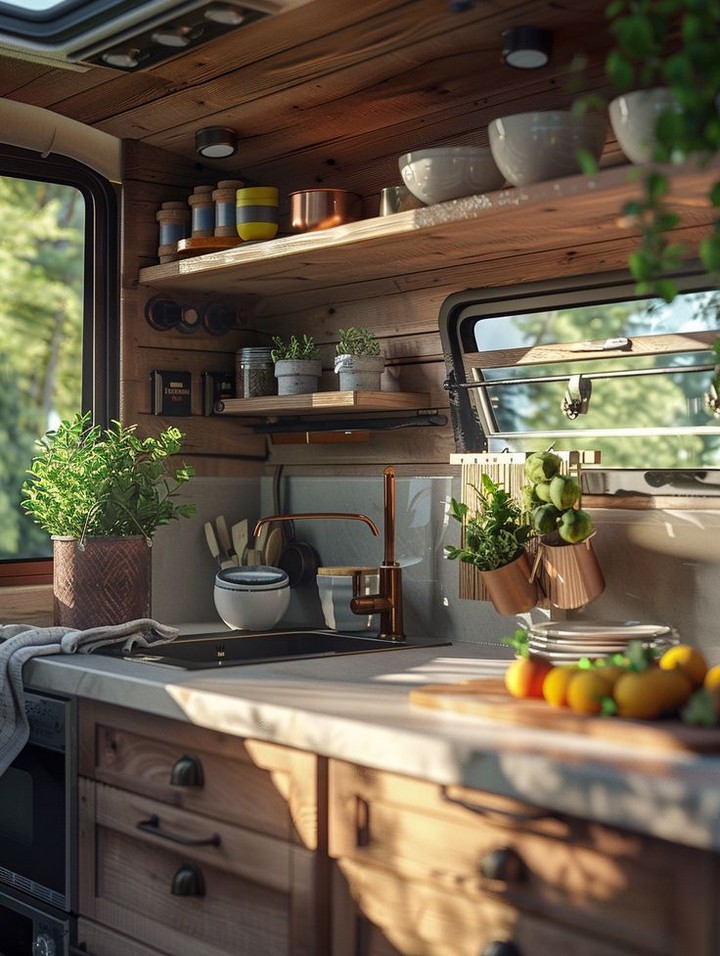
Replace standard hardware with twisted branches or driftwood pieces for drawer pulls and door handles that enhance the rustic aesthetic while remaining functional.
Backsplash Ideas
Though often overlooked in van builds, backsplashes protect walls while offering significant design opportunities.
21. Herringbone Wood Accent Walls
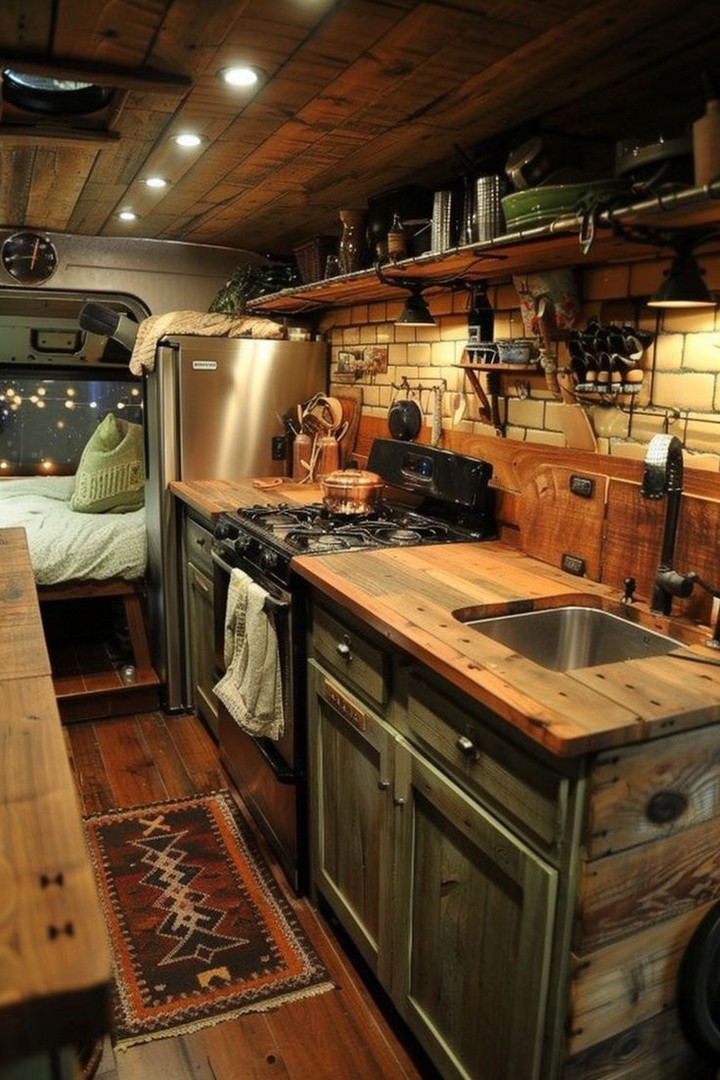
A herringbone pattern using thin wood pieces creates visual complexity without overwhelming the small space. This traditional pattern brings sophistication to rustic materials.
22. Burned Wood Shou Sugi Ban Treatment
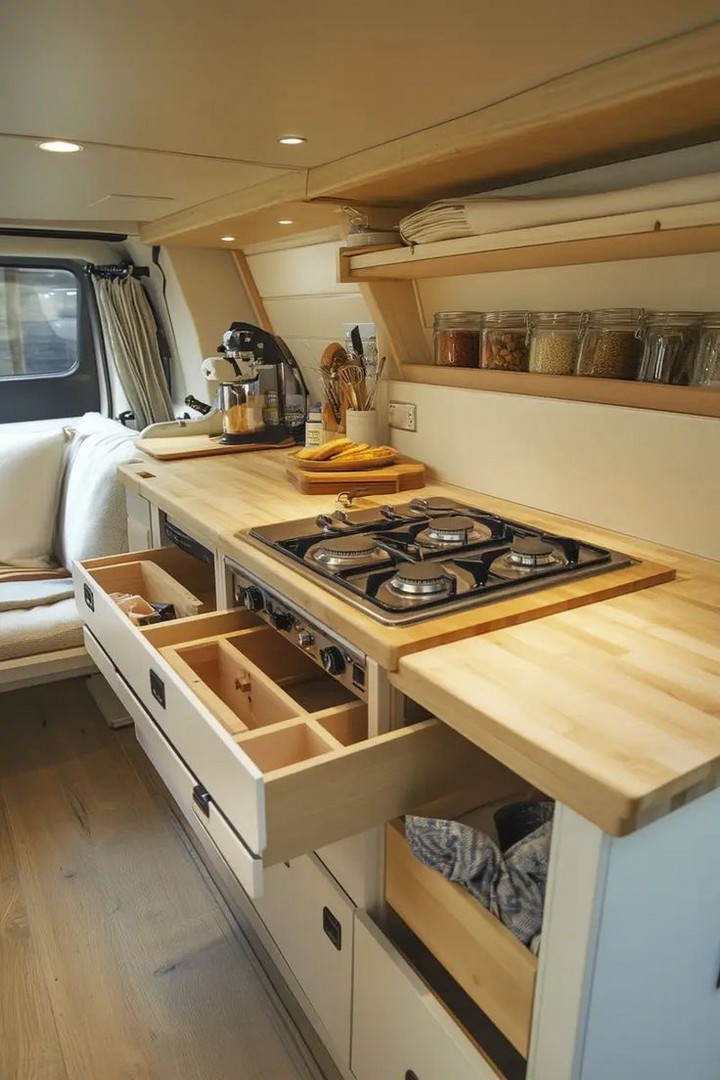
This Japanese wood preservation technique chars the surface to create a distinctive blackened appearance with enhanced durability and water resistance—practical benefits for areas near water sources.
23. Cross-Cut Log Slice Mosaics
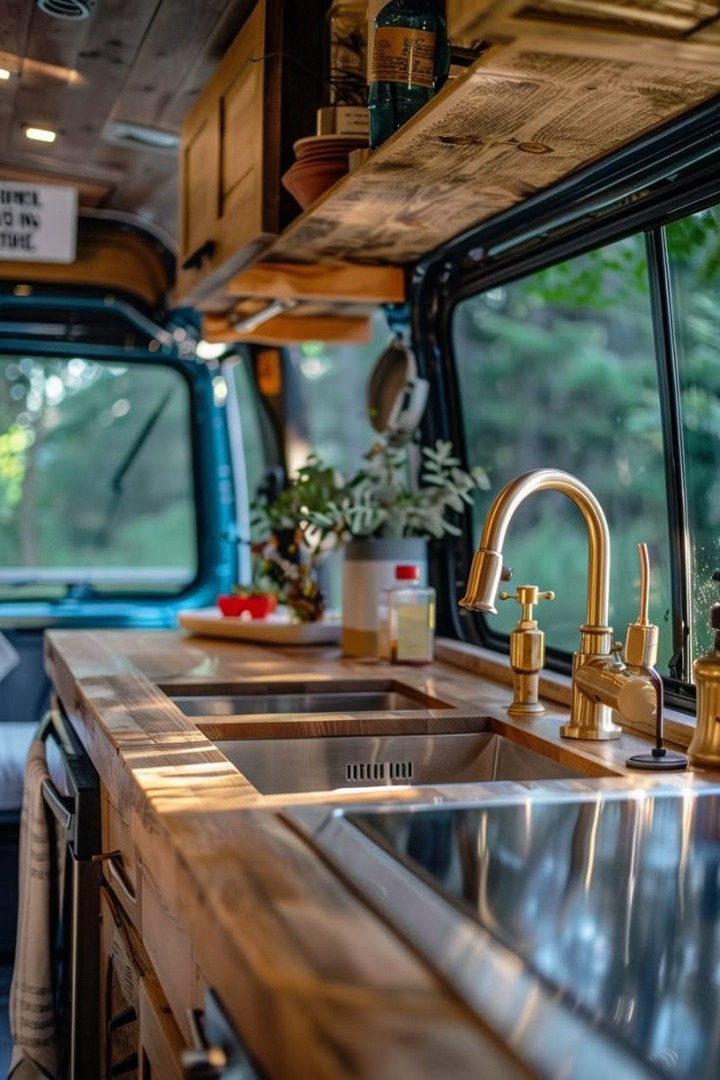
Thin slices of branches arranged in a mosaic pattern create a striking organic backsplash that showcases the complete circular grain pattern of the wood.
24. Reclaimed Pallet Wood Applications
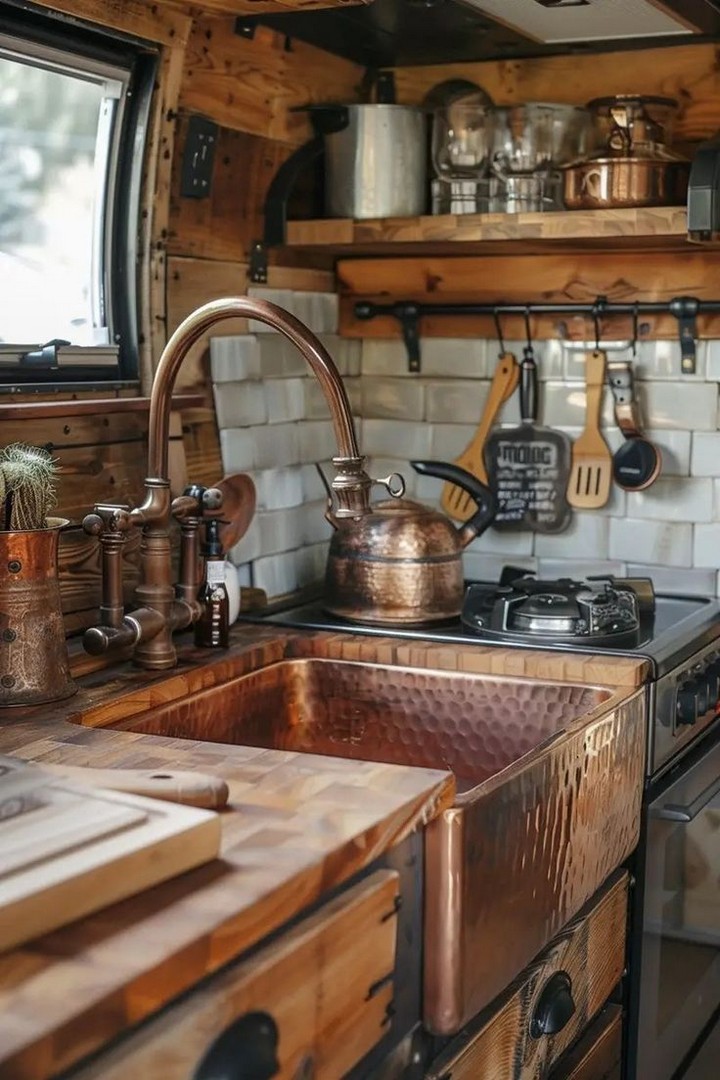
When properly cleaned and finished, pallet wood provides an economical backsplash material with built-in character and color variation. Its standard dimensions also simplify installation.
25. Wood and Metal Combined Backsplashes

Alternate wood strips with thin metal elements for a backsplash that combines rustic and industrial elements while providing excellent heat resistance behind cooking areas.
Sink and Faucet Integration
The sink area presents unique opportunities for rustic wood expression.
26. Hand-Carved Wooden Sink Basins
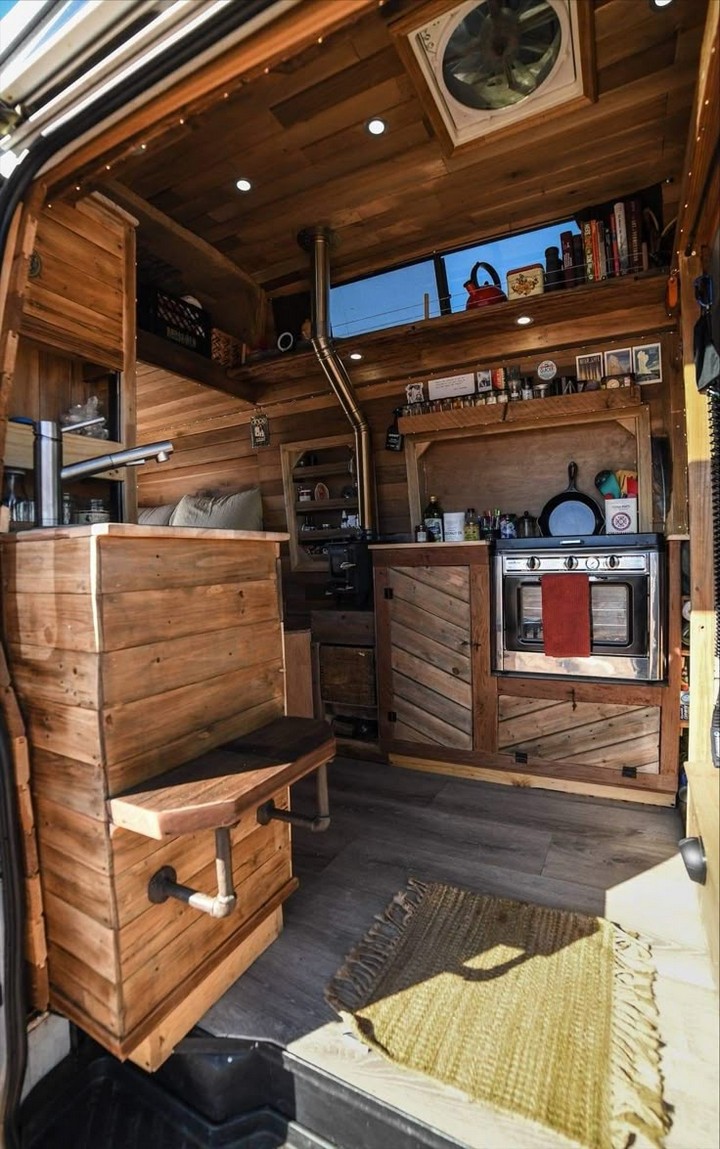
For truly distinctive designs, consider a carved wooden sink basin. When properly treated with marine-grade finishes, these can provide years of service while serving as conversation pieces.
27. Wooden Sink Surrounds and Aprons
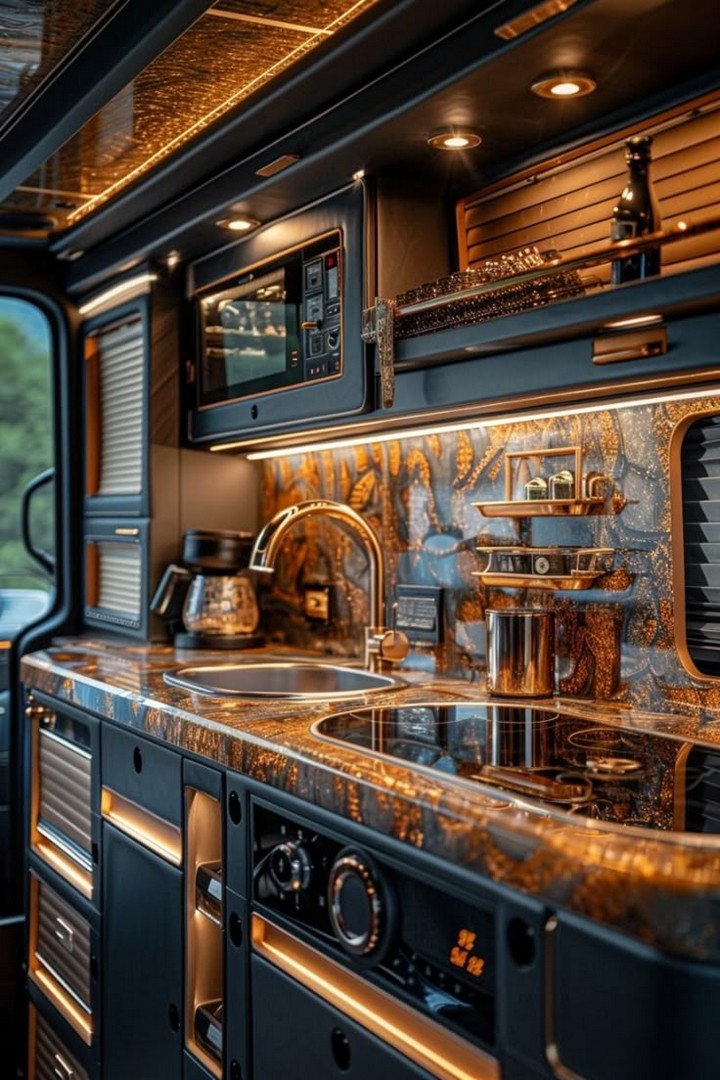
Pair a conventional metal or composite sink with a custom wooden apron or surround that frames the basin and ties it visually to surrounding wood elements.
28. Branch or Driftwood Faucet Handles
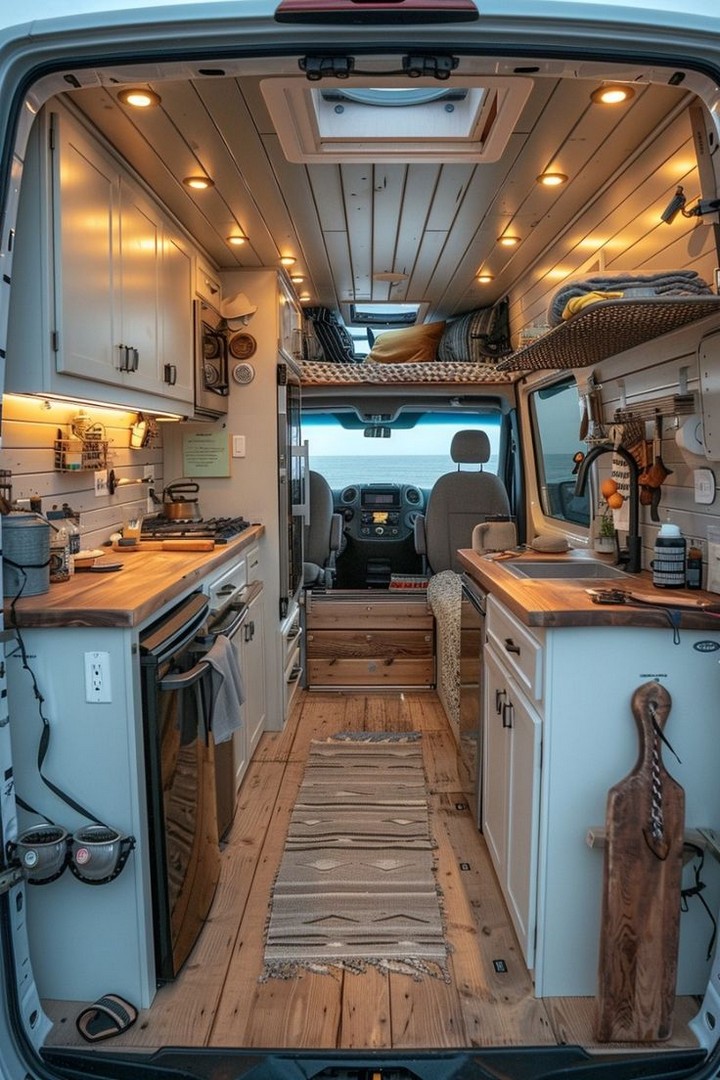
Replace standard faucet handles with custom wooden alternatives, perhaps incorporating interesting branch formations or smoothed driftwood pieces.
29. Integrated Wooden Drain Boards

Extend your countertop design with built-in sloped drain boards that direct water back toward the sink while providing additional functional workspace.
30. Hidden Sink Cover Workspaces
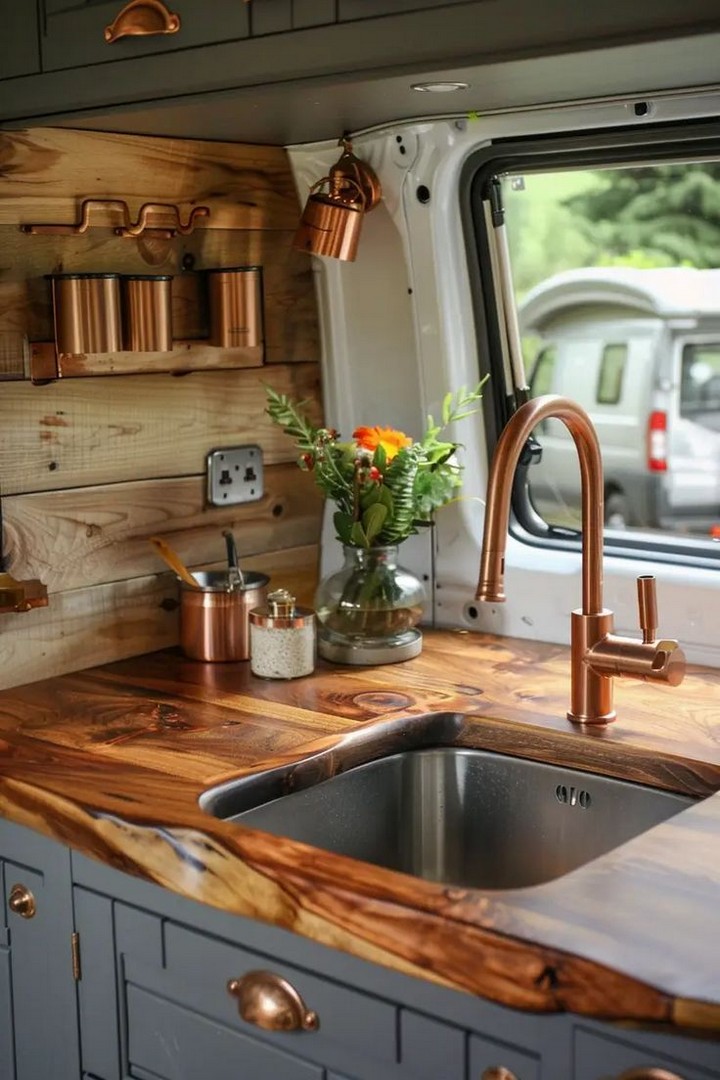
Create wooden sink covers that sit flush with surrounding countertops, effectively disappearing the sink when water access isn’t needed and maximizing limited counter space.
Specialized Storage Features
Thoughtful storage solutions define successful compact kitchens.
31. Custom Wooden Spice Rack Systems
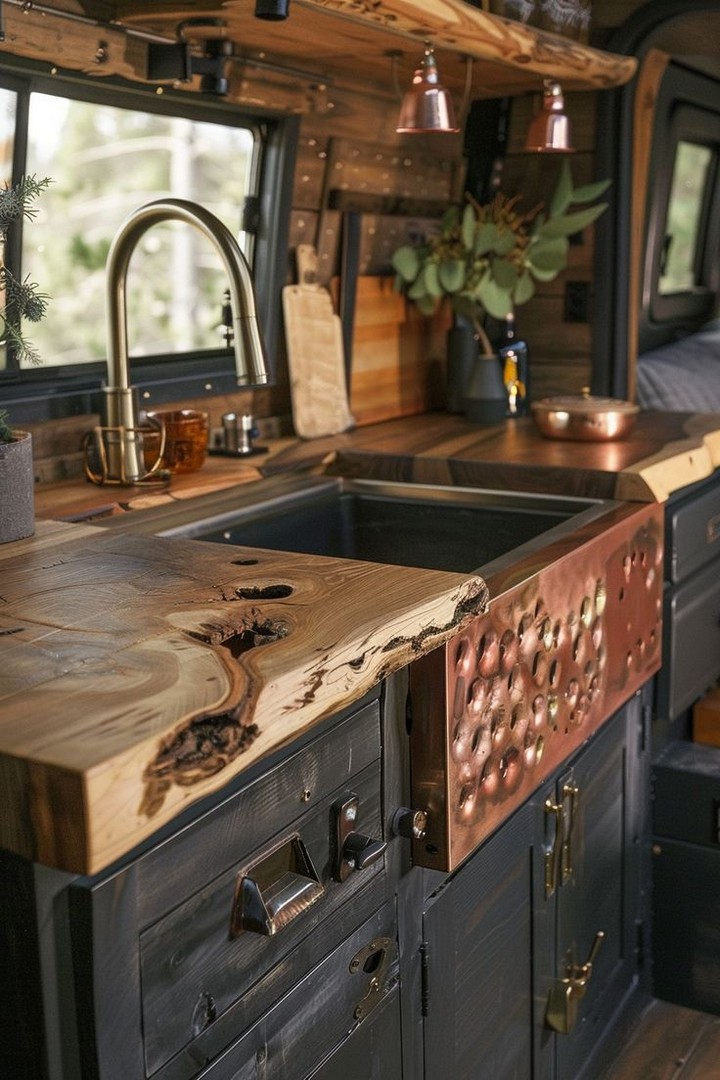
Design spice storage that prevents bottles from becoming projectiles during travel. Recessed shelves with slight lips or angled storage blocks keep ingredients secure yet accessible.
32. Knife Block Wall Integration
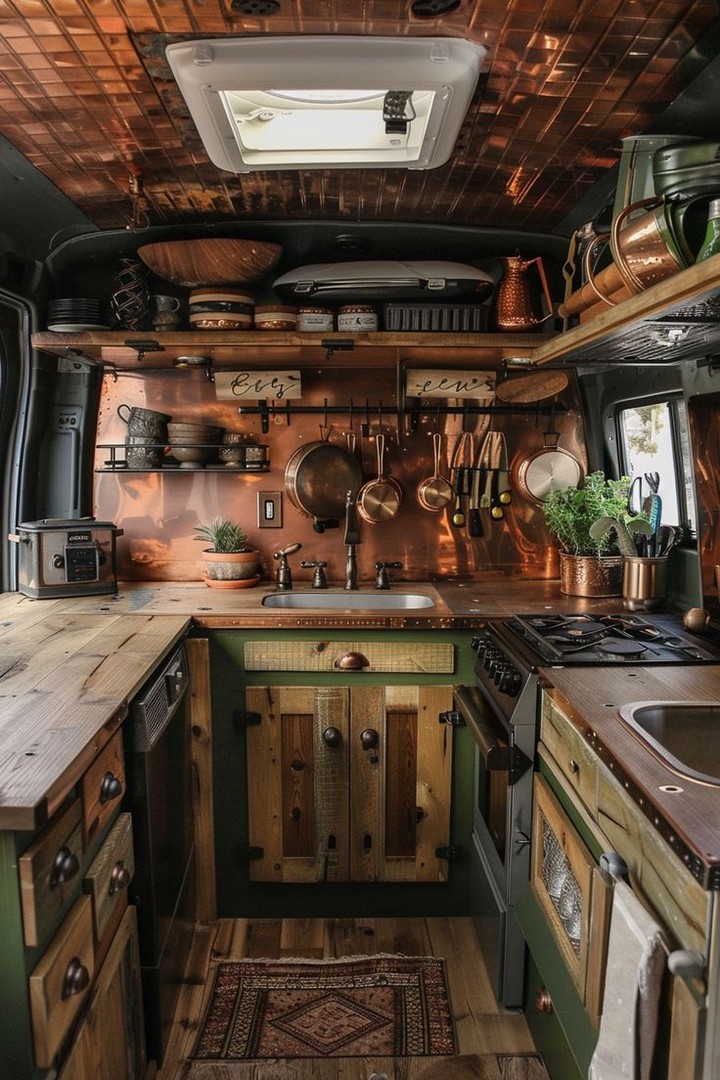
Embed a knife storage solution directly into wall paneling, saving valuable counter and drawer space while keeping sharp tools secure during transit.
33. Fold-Down Extension Tables
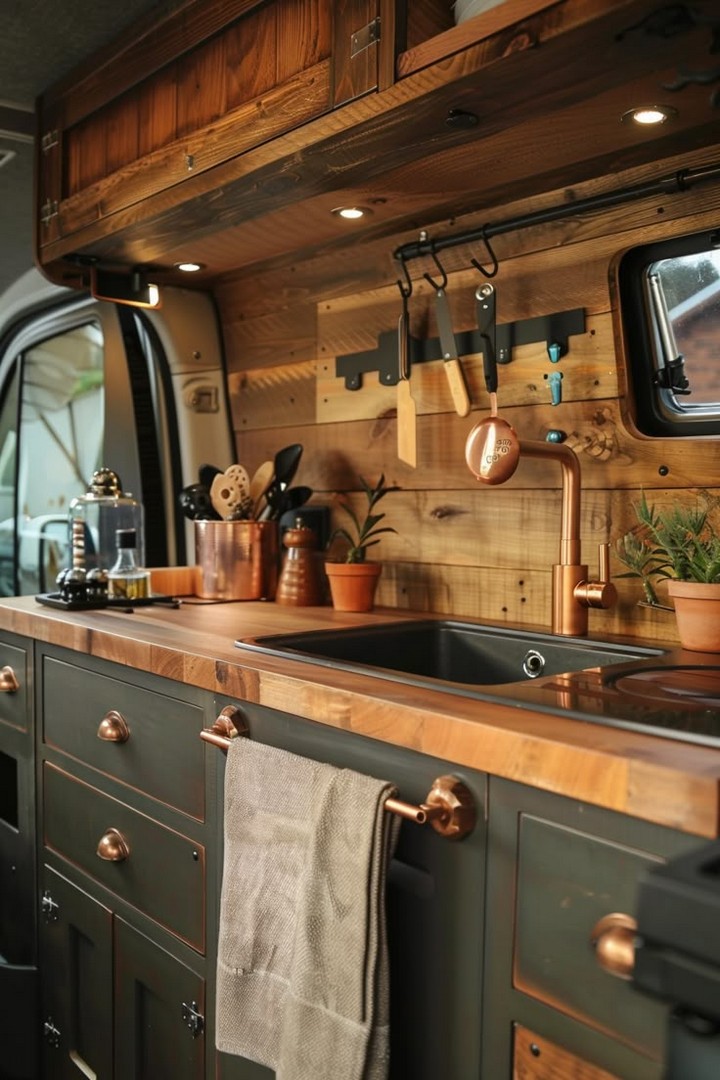
Wall-mounted wooden extensions that fold down when needed and disappear when not in use can double your functional space during meal preparation.
34. Vertical Utensil Storage Solutions
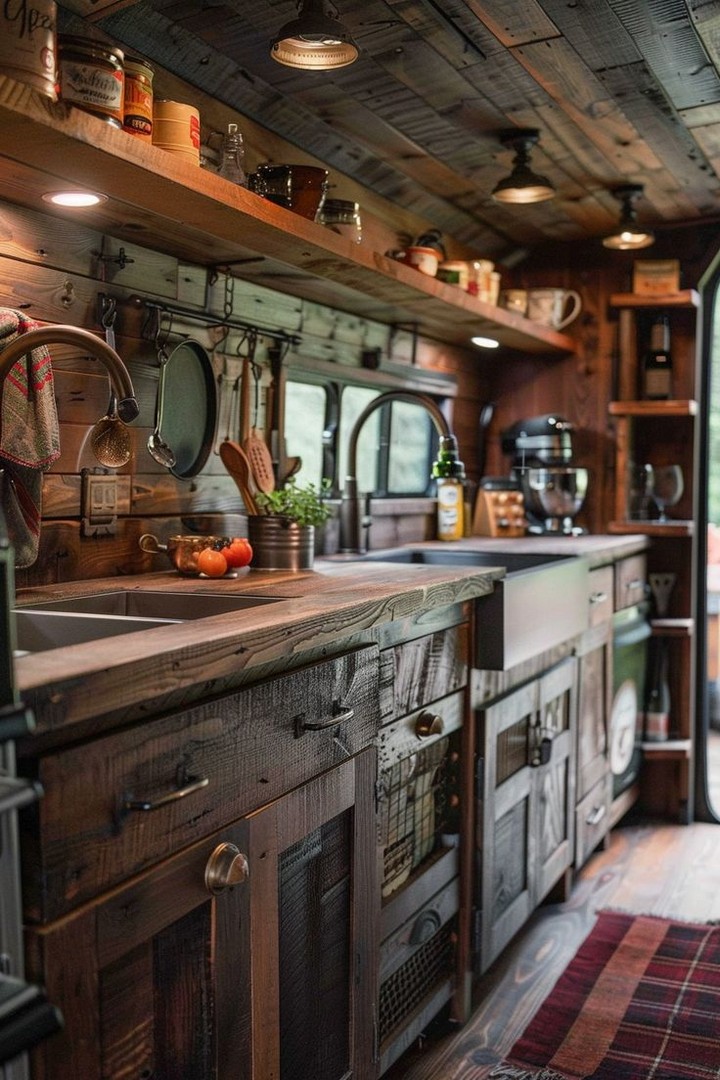
Utilize wall space with pegs, hooks, or custom wooden holders that display frequently used utensils as functional art while keeping them within easy reach.
35. Stemware Rack Installations
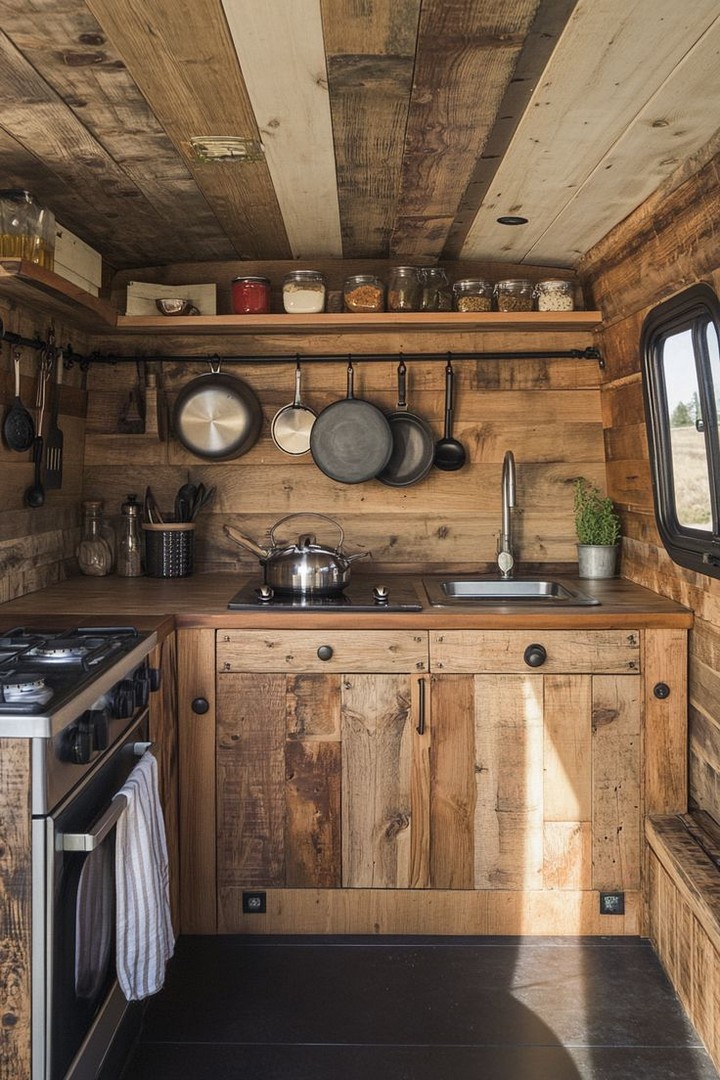
Secure wine glasses and mugs with under-cabinet wooden racks that prevent breakage during travel while making efficient use of otherwise unused space.
Appliance Integration
Combining modern appliances with rustic wood requires thoughtful design approaches.
36. Wooden Appliance Garage Hideaways
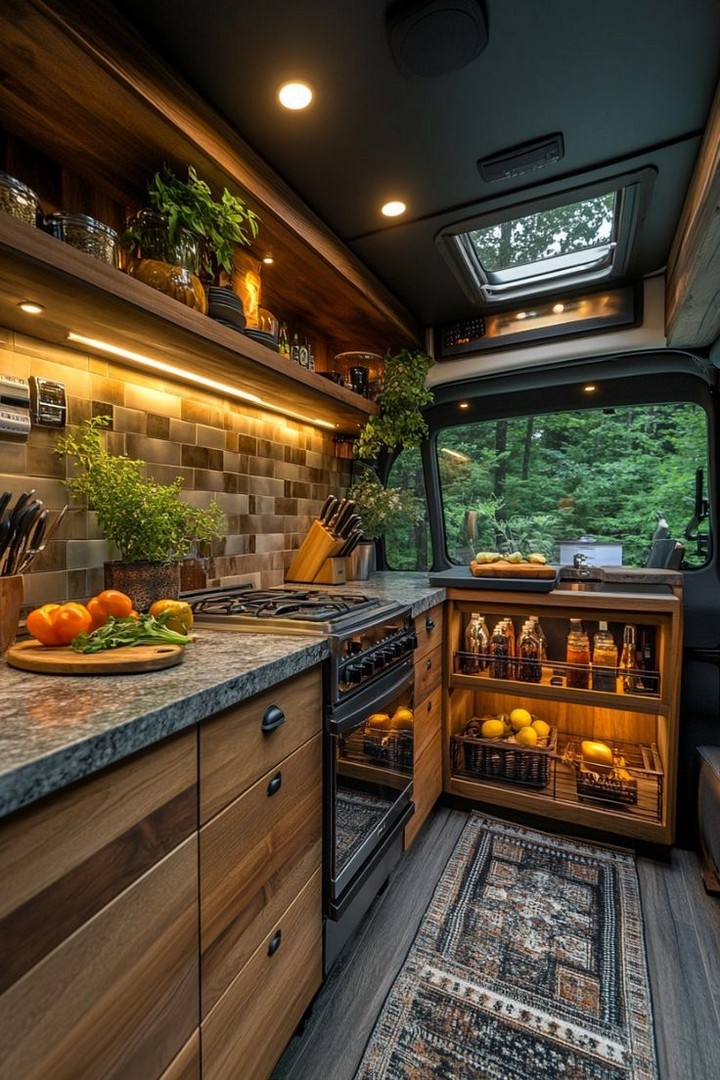
Create retractable doors or covers that conceal modern appliances when not in use, maintaining the rustic aesthetic while enjoying contemporary conveniences.
37. Custom Range Hood Surrounds
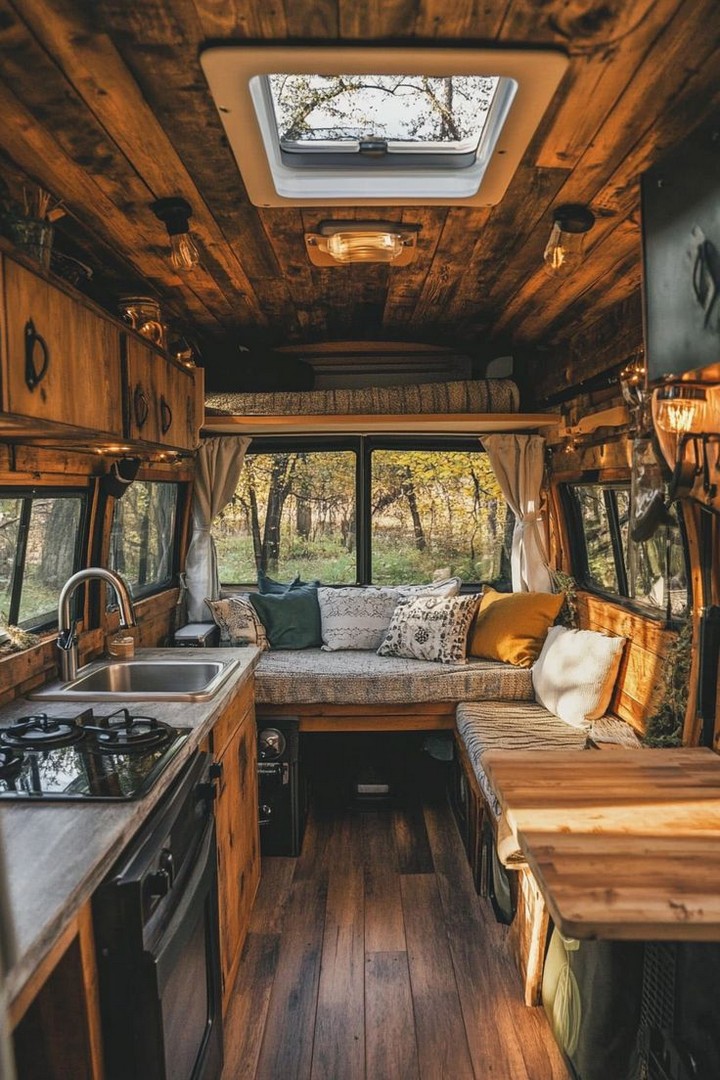
If your design includes exhaust ventilation, a wooden range hood enclosure transforms a utilitarian feature into a design statement that complements your overall aesthetic.
38. Integrated Cutting Board Over Cooktop
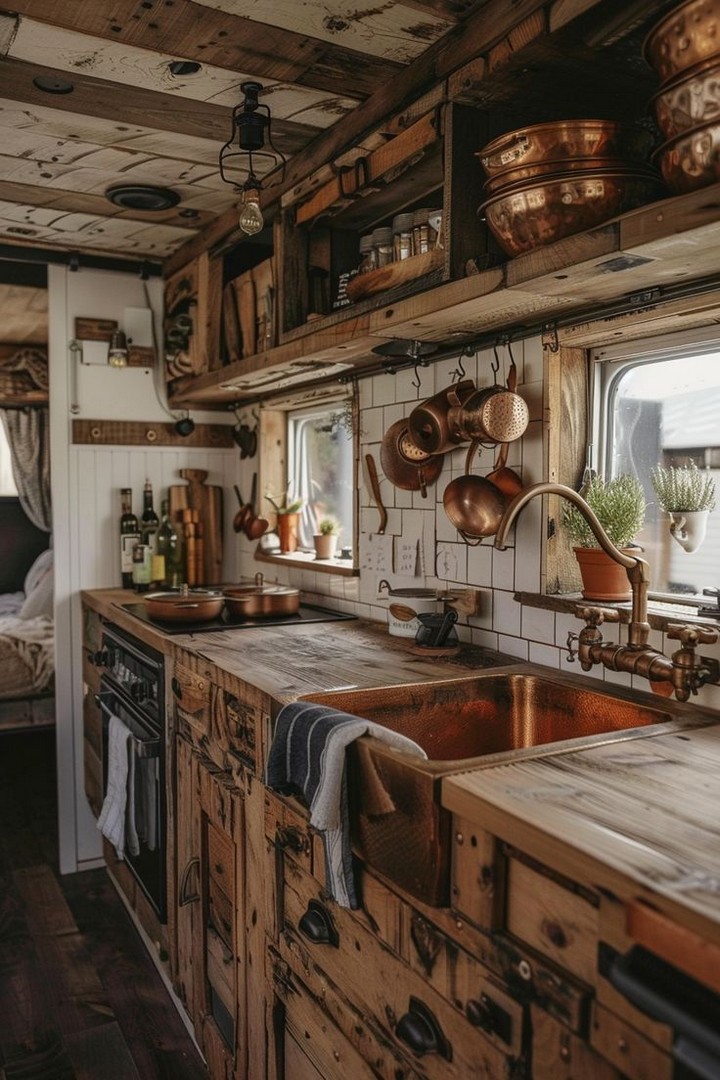
A sliding wooden cover for your cooking surface provides additional workspace when the stove isn’t in use—particularly valuable in extremely compact builds.
39. Refrigerator Panel Retrofits
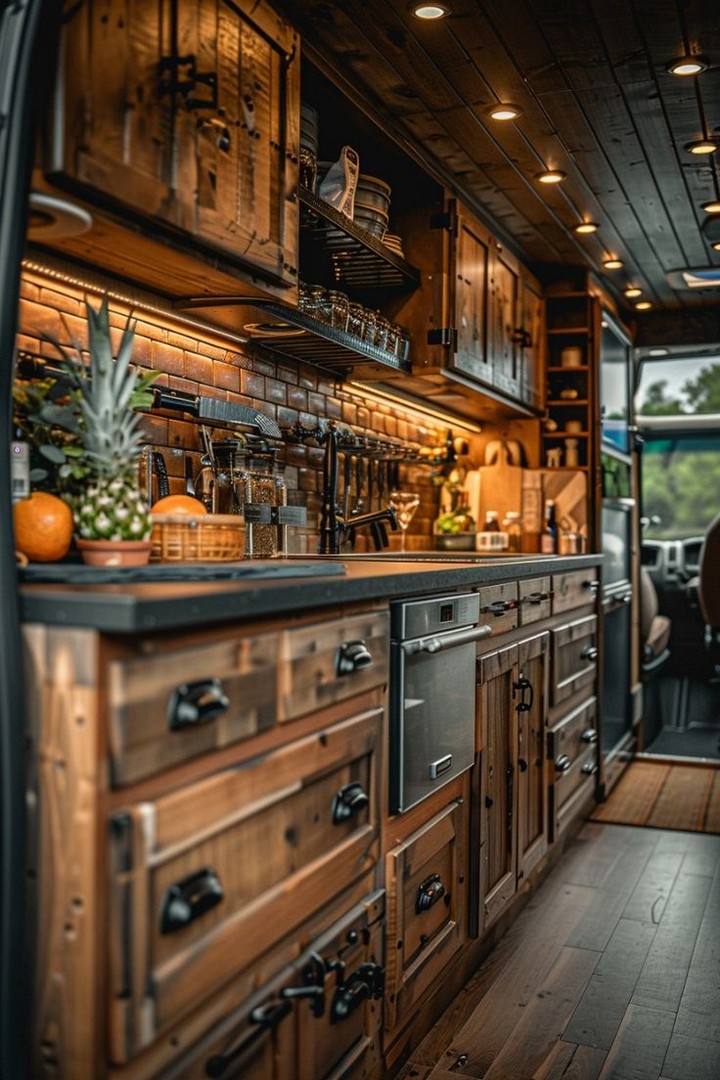
Many compact refrigerators accept custom panels. Replace the standard door with a matching wooden front that blends seamlessly with surrounding cabinetry.
40. Hidden Charging Stations
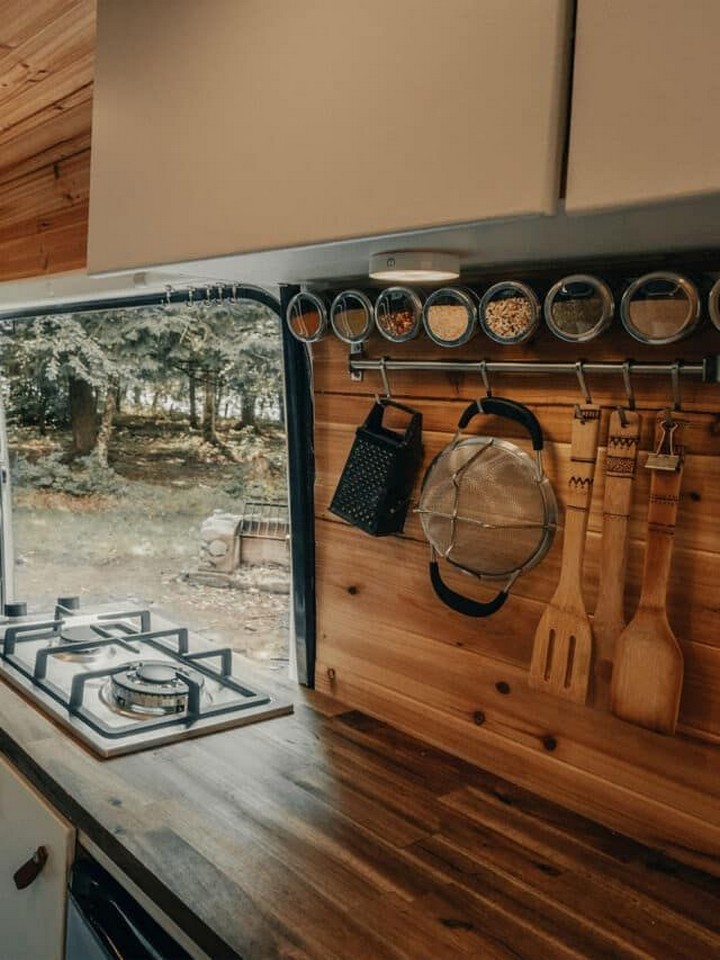
Incorporate charging ports for devices within wooden elements, perhaps behind small doors or within drawers, keeping technology accessible but visually minimized.
Finishing Touches and Accessories
Small details often make the biggest impact in compact spaces.
41. Reclaimed Hardware Integration
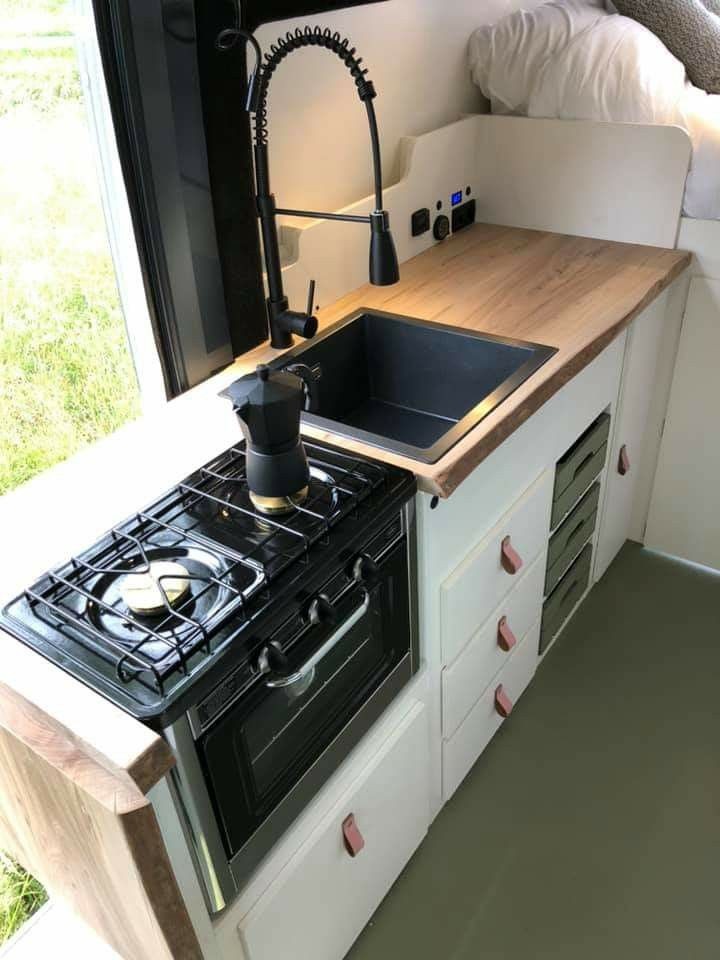
Source vintage knobs, latches, and pulls from architectural salvage suppliers to add authentic aged character that complements the rustic wood theme.
42. Contrasting Wood Inlays
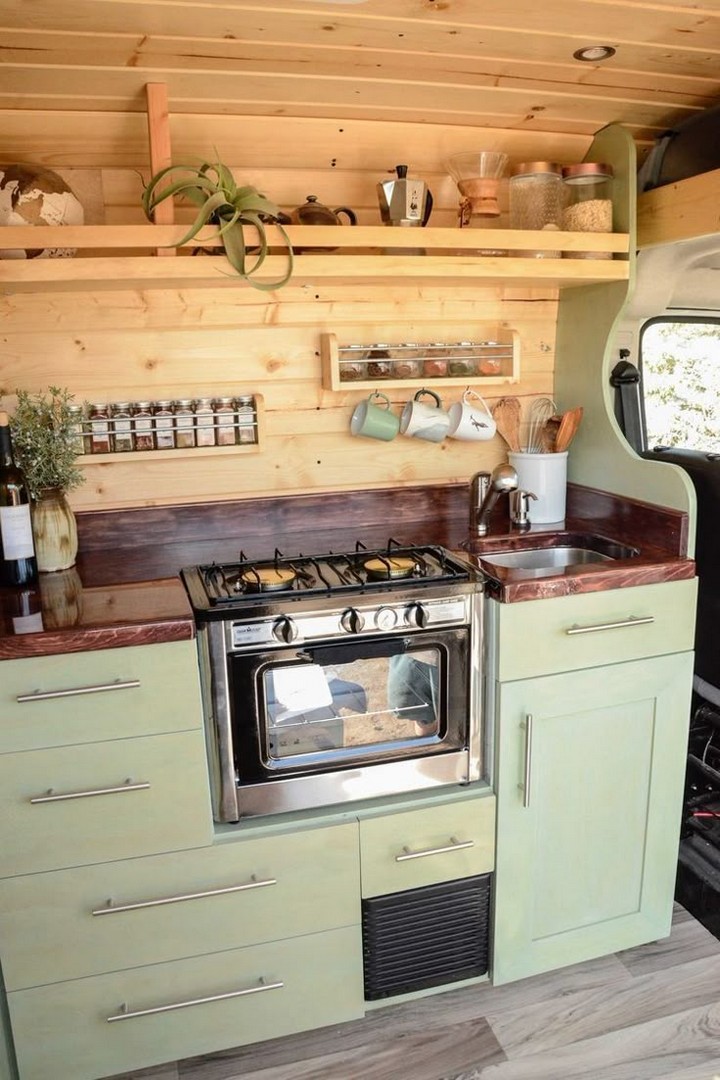
Add visual interest with inlaid wood designs using contrasting species. Even simple geometric patterns create focal points that elevate the overall design.
43. Wood-Burned Custom Details

Personalize your kitchen with pyrography (wood burning) that adds custom designs, meaningful quotes, or useful information like measurement conversions directly into wooden surfaces.
44. Integrated Wooden Lighting Solutions
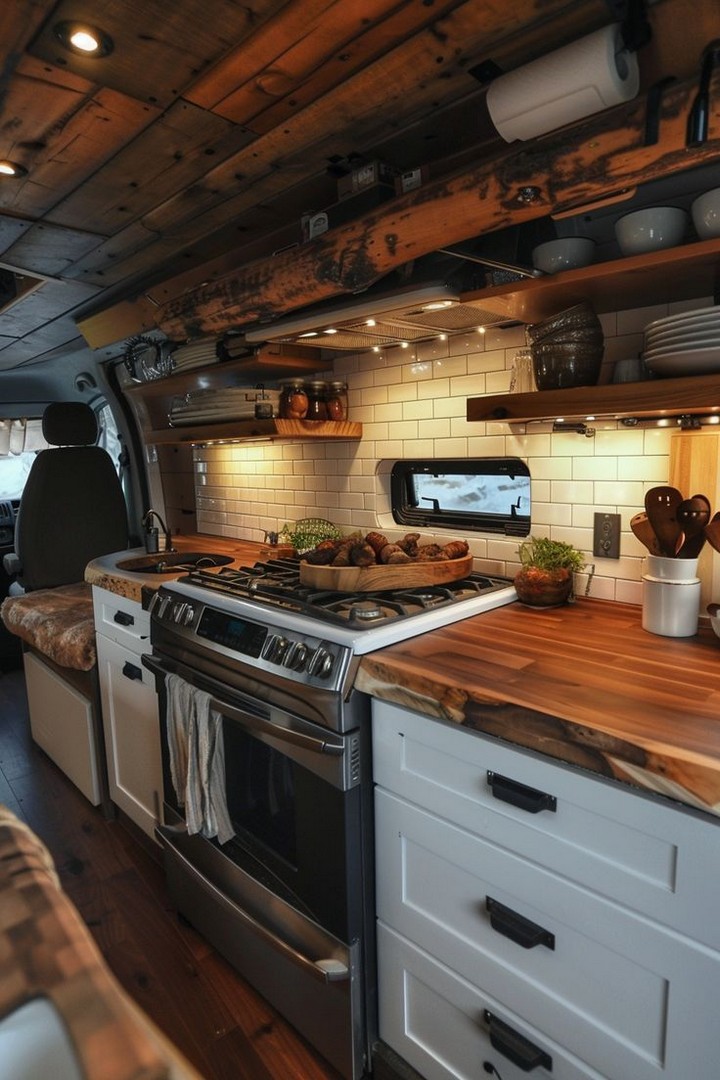
Craft light fixtures from complementary wood elements, perhaps incorporating LED strip lighting within wooden valances or creating pendant fixtures from hollow wooden forms.
Creating Your Unique Rustic Wood Van Kitchen
The 44 ideas presented here serve as inspiration rather than rigid prescription. The beauty of rustic wood in Sprinter van kitchens lies in the opportunity for personalization and adaptation to your specific needs and aesthetic preferences.
Whether you’re drawn to the warmth of honey-toned pine, the rich character of reclaimed oak, or the striking grain patterns of exotic species, incorporating wood elements connects your mobile living space to age-old traditions of craftsmanship while creating a uniquely functional environment for modern nomadic living.
The rustic wood kitchen bridges past and present combining traditional materials with innovative space solutions, all while providing the essential functions needed for comfortable life on the road. The result transcends mere utility to create a space that feels like home, regardless of where you park.
Share Your Rustic Wood Van Kitchen Journey
Have you incorporated rustic wood elements in your Sprinter van kitchen? We’d love to see your creative solutions and hear about your experiences. What unexpected challenges did you encounter? Which wood species have performed best in your mobile environment? Share your insights in the comments below!
For those still in the planning phases, which of these ideas resonates most with your vision? What questions do you have about implementation? Our community of experienced van builders is here to help guide your project to success.

